11th Field Hospital Unit History
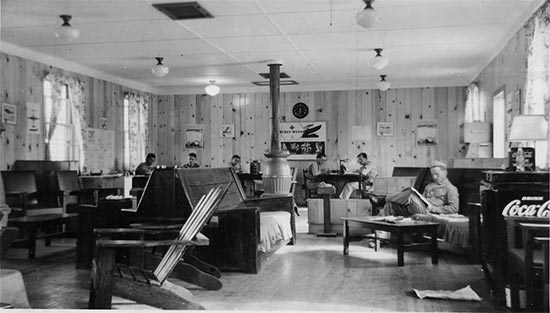
Vintage photo illustrating the dayroom at Camp White, Medford, Oregon, where the 11th Field Hospital was originally activated on 1 August 1942.
Introduction & Activation:
The 11th Field Hospital was originally activated by the War Department at Camp White, Medford, Oregon, Ninth Service Command (Division Camp; acreage 49,638; troop capacity 1,884 Officers and 35,557 Enlisted Men –ed) on 1 August 1942 and assigned to Eighth Service Command, at Camp Carson, Colorado Springs, Colorado (Division Camp; acreage 68,355; troop capacity 2,707 Officers and 44,240 Enlisted Men –ed), on 17 November 1942. The organization’s Commanding Officer was Major Herman E. Wilkinson, MC who was officially appointed by General Orders Number 1, Headquarters, 11th Field Hospital, Camp Carson, Colorado, dated 30 January 1943. His Executive Officer was First Lieutenant S. D. Ellman, MC.
On 13 August 1942 the cadre for the new organization left Gowen Field, Boise, Idaho, Ninth Service Command, at 1600 hours. They arrived at Camp White, Medford, Oregon, around 2200 the following day. On 13 November, the new organization left Camp White, Oregon, at 1250 hours, departing for Camp Carson, Colorado Springs, Colorado. The group reached Camp Carson, Colorado Springs, at 0030 in the early morning of 17 November 1943. After being organized, the Hospital was attached to the Northwest Service Command for further operations in the Zone of Interior.
Service:
The 11th Field Hospital departed New York Port of Embarkation on 29 April 1943 with destination North Africa, where it arrived on 11 May 1943. The organization was to serve in the Mediterranean Theater and see combat in the Sicily Campaign, the Italian Campaign, and would eventually land in Southern France in August of 1944. The Hospital rendered miscellaneous medical services during the Rhineland Campaign, and also participated in the Central Europe Campaign.

On 13 August 1942 the cadre for the newly organized 11th Field Hospital left Gowen Field, Boise, Idaho, for Camp White, Medford, Oregon, where they arrived around 2200 hours the following day.
The 11th Field was the first unit to act as a surgical 3-Unit Hospital organization in divisional areas, and the FIRST Hospital to use penicillin in Europe. Also important to note is that the organization was apparently the only Hospital to have been attached to a Combat Team for the Invasion of Sicily (attached to the 16th RCT –ed).
After return to the ZI, the 11th Field Hospital was inactivated at Camp Myles Standish, Boston, Massachusetts, on 21 November 1945.
After the war, the 11th Field Hospital returned to Europe where it was located in Stuttgart-Bad Cannstatt, Germany. The organization took over a former 1200-bed Wehrmacht Lazarett, originally occupied by the 1000-bed 216th General Hospital since 8 August 1945, which was eventually redesignated the 500-bed 387th Station Hospital on 1 April 1946, and once more reorganized as a 250-bed Hospital on 30 June 1949. On 25 August 1949, the 387th Station Hospital, which had operated as the Orthopedic Center of the US Army European Command, was inactivated and replaced by the recently re-activated 11th Field Hospital. At that time, the Hospital’s new CO became Colonel Abner Zehm, MC, also Surgeon of the Stuttgart Military Post and former Surgeon, “Cent Force” plus 2d Armored Division, during the WWII Sicily Campaign.
Organization:
The unit was to function in accordance with the mission of a 400-bed Field Hospital as described in T/O 8-510 dated 28 February 1942, consisting of one (1) Headquarters Company and three (3) Clearing Platoons (subsequently designated Unit I – II – III –ed). Each unit was capable of operating independently and able to care for maximum 100 patients. When combined the organization had a capacity of 400 patients, and could give a mobile Station Hospital type of medical care. As per above T/O it was assumed that 17 Officers, 18 Nurses, and 211 Enlisted Men were required to enable the organization to operate. Headquarters Company included 2 Officers, no Nurses, and 19 EM; while each individual Clearing Platoon (or Unit) comprised 5 Officers, 6 Nurses, and 64 Enlisted Men.
The Distinctive Insignia for the 11th Field Hospital was originally approved on 8 December 1942. It was created by Walt Disney’s studios, and consisted of a gold wing bearing a maroon cross with a gold bear’s head caboshed, and a small title indicating 11th F.H. A maroon scroll with white lettering and motto SERVIR was attached below. The DI was rescinded 19 July 1961, and eventually re-instated and authorized for the 21st Evacuation Hospital on 29 January 1968 with minor changes. The new Distinctive Insignia, effective 16 December 1992, now represented the 21st Combat Support Hospital, with revised description and symbolism. The motto changed into FEAR NOT.
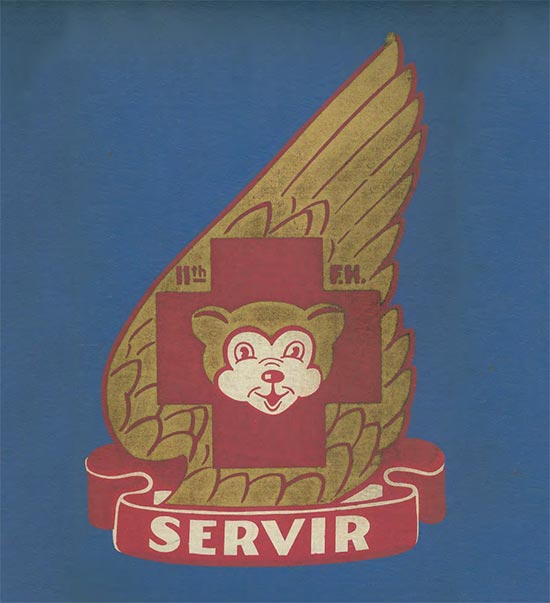
The Distinctive Insignia for the 11th Field Hospital was originally created by the Walt Disney’s Studios and approved 8 December 1942. It consisted of a gold wing bearing a maroon cross with a gold bear’s head caboshed, and a small title indicating 11th F.H. A maroon scroll with white lettering and motto SERVIR was attached below. The DI was rescinded in 1961 and later amended, redesignated and authorized for the 21st Combat Support Hospital, with a revised motto stating FEAR NOT.
Training:
Basic Training was introduced to the staff and personnel at Camp White, Medford, Oregon. Drill, marches, and calisthenics, became daily activities, and since Camp White was a newly constructed camp in the Agate Desert in Oregon, training and exercising in the hot sun took its toll. Some of the many activities consisted in piling rocks, planting trees, constructing walks, and doing some overall landscaping of the installation. Meals were taken at the 17th Hospital Center. After a few days of trials, a training schedule was set up, yet road marches and drill continued, but this time more medical subjects were included such as the litter drill. Road marches would often lead to Rouge River, and the men even crawled up Table Top Mountain. One of the difficulties encountered during training was the lack of hospital equipment which only arrived about 10 September, which meant that there was little time to get acquainted with it all, let alone use it in the field.
Black-out driving exercises were conducted on 8 – 9 October. On 21 and 22 October 1942, the entire Hospital was sent on a 2-day bivouac in a former CCC-camp. Motor convoys and ambulance evacuation were scheduled to places like Crater Lake. Lectures were also part of the daily training activities.
Shortly after arrival of the equipment, alert orders were received for a possible movement to the CBI Theater, resulting in the cancellation of all passes and furloughs. The equipment was thoroughly checked, inventoried, packed and crated, and then, suddenly the orders were cancelled. Orders did however get through for a movement to Camp Carson in Colorado.
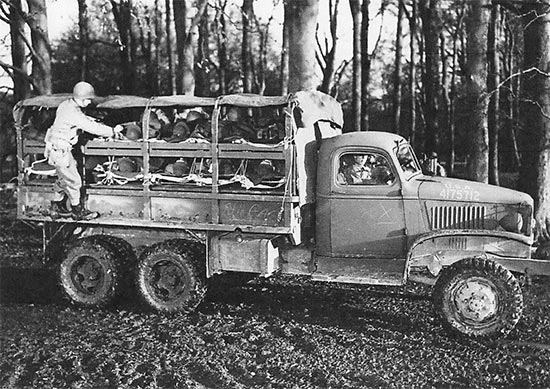
Photo illustrating another way of transporting patients to a Receiving Station, not by a 3/4-ton ambulance, but by the ubiquitous 2 1/2-ton truck.
Leaving their initial Basic Training behind, the entire organization with 14 freight cars of equipment moved to Camp Carson, Colorado Springs. It was a great change from Camp White, Oregon. Training was begun as soon as it was felt that the unit had become acclimated to the high altitude. Many men were sent on TD to the Post Station Hospital. Road marches, drill, calisthenics, lectures, night marches, compass reading, day marches, bivouacs, unit setups, tent pitching, all were part of a vast program. Many exercises conducted in the field took place in snow-covered land. After trying to get acquainted with the methods of tent pitching (particularly the large tents proved a problem), loading and unloading of trucks was practiced, and driving in motor convoy, day and night followed.
Additional equipment continued to come in and everything had to be cross-checked, inventoried, packed and finally crated, and stenciled “1254-H”.
On 19 April 1943, the 11th Field Hospital, began an eastbound journey across the states, arriving at Camp Kilmer, New Jersey, at 1245 hours, 22 April 1943. The unit’s strength at the time consisted of 16 Officers – 17 Nurses – and 196 Enlisted Men.
Overseas Movement:
Final processing took place at Camp Kilmer, Stelton, New Jersey (Staging Area for New York Port of Embarkation; acreage 1,815; troop capacity 2,074 Officers and 35,386 Enlisted Men –ed). This period was short, but filled with receiving immunization shots, checking final clothing, drawing new equipment, marking the new clothing and individual equipment, and practicing embarking and disembarking, followed by a final physical test. After some last short passes to New York City, the organization was alerted on 27 April and ordered to leave the barracks fully packed at 2330 hours, and march off to a waiting blacked-out troop train which was to take them to Staten Island. Once arrived, it was barely 0400, the men boarded the ferry which would take them up to the pier. American Red Cross girls were waiting for them with coffee, donuts, and candy. At the gangplank, individual last names were yelled out, which had to be acknowledged by the troops prior to boarding.
The transport “Evangeline” left Pier 366 at 0420 and slipped out in the morning fog of 29 April 1943, and once out at sea joined the remainder of the convoy on its way across the Atlantic Ocean. The Enlisted Men were stuck on a crowded ship with bad food, while Officers had many advantages. Pastimes were few, reading, playing cards, singing, and trying to rest or sleep. The smell of the mess hall, the rough seas, and the mass of people aboard, made the voyage of many a soldier miserable. Helmets often served as buckets in case the owner couldn’t make it to the latrine in time. Abandon Ship drills, fire drills, and deck calisthenics helped pass some time too. Rumors of enemy submarines were prevalent, but fortunately none were encountered.
It was a great day when the first seagulls made their appearance and land could no longer be far away. The “Evangeline” passed The Rock of Gibraltar on 10 May 1943, crossing into the Mediterranean, and the next day she sailed into Oran harbor, Algeria.
North Africa:
Departure from New York P/E took place aboard USAT “Evangeline” on 29 April 1943 (transport code designation NY 366) with arrival at Oran, Algeria, 11 May 1943, and debarkation at 1700 the same day. Upon its arrival the Hospital was attached to MBS (Mediterranean Base Section-ed), effective 27 May 1943.
The organization entrucked for “Arab Hill” (sometimes nicknamed “Goat Hill” or “Misery Hill”) or MBS Staging Area 20, where many newly-arrived units staged after reaching North Africa. The next day KP and guard duty rosters were published and work details assembled to move to the Oran docks to pick up the unit’s supplies and equipment. When all supplies had been collected, the personnel were allowed passes to visit Oran. “Arab Hill” or “Goat Hill” would never be forgotten, because of the wind, the dust, the intense heat during day, and the cold during night, the guard patrols, the Arabs scrounging or stealing, and the risks of wandering at night on one’s own. Swimming was possible and showers were eventually made available.
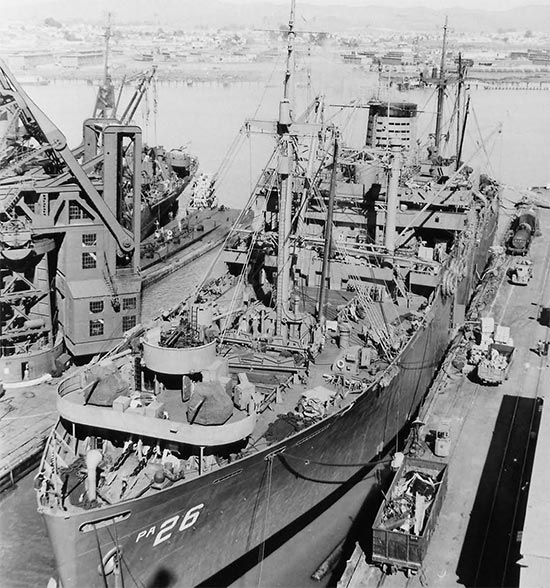
Vintage photo illustrating USAT “Samuel Chase”, APA-26 which carried the organization from Oran to Algiers, Algeria on 12 June 1943, with orders to prepare for the unit’s participation in Operation “Husky”, the Invasion of Sicily.
The 11th Field Hospital left their staging area 27 May 1943, moving to Port-aux-Poules, another Staging and Training Area. The main advantage was that the EM were free to enjoy swimming after duty hours; the disadvantages were many: millions of mosquitoes, heat, dust, dysentery, malaria. The place became the organization’s big Staging Area for the Sicily operation. In preparation for the invasion, all equipment had to be uncrated and thoroughly checked, and the equipment and supplies split and divided among the three Hospitalization Units. Lectures and instructions abounded in view of the coming amphibious operation. It was recommended to learn how to swim, how to debark from a landing craft, how to proceed with an assault landing, and much more about what to expect!
Leaving Unit III and the Nurses behind, the 11th Field sailed for Algiers, Algeria, aboard USAT “Samuel Chase” APA-26, leaving Oran at 1315, 12 June 1943, while trucks loaded with the organic equipment traveled overland to Staoueli, Algeria. The ship arrived at Algiers around midday, Personnel debarked around 1330 hours and immediately proceeded by motor convoy to Staoueli. The trucks carrying the organization’s equipment were loaded aboard ships on 23 and 24 June. On 26 June 1943, Headquarters, and Units I and II embarked on LST 337 in Algiers and left Algiers harbor at 1130, 27 June. Meanwhile Unit III embarked on LST 391 sailing from Arzew harbor at 0800 the following morning. The first group, traveling aboard LST 337 transferred to British-manned LCIs and after landing on 30 June 1943, proceeded on foot and in British trucks to the Virginia Staging Area, near Ariana, Tunisia. They were joined by the second group on LST 391, which arrived on 3 July 1943, and following debarkation, were transferred to another Staging Area near Carthage, Tunisia.
LST 337 and LST 391 re-embarked the hospital personnel and finally set sail at 0600 and 0700 hours respectively, 8 July 1943, for Sicily.
Sicily:
Unit III of the 11th Field Hospital was attached to the “Cent Force” which landed at Scoglitti Beachhead, Sicily, 10 July 1943, during “Operation Husky”. It must be said that only a few Officers and Enlisted Men landed, while Unit III remained on board LST 391, going through some German air raids. Although landings were initially delayed by heavy seas and opposed by some Italian units, the assault units were ashore by 0600 hours and the Beachhead secured by end of the day. By 12 July 1943, the Scoglitti Beachhead was already 15 miles deep. Movement inland was under continuous enemy fire in an all-out effort to knock out the invasion fleet and the assault troops. Nevertheless, Unit III debarked around 0800 hours, 13 July 1943, and proceeded to a site some three miles from Vittoria to bivouac. They set up their first Hospital on 14 July.
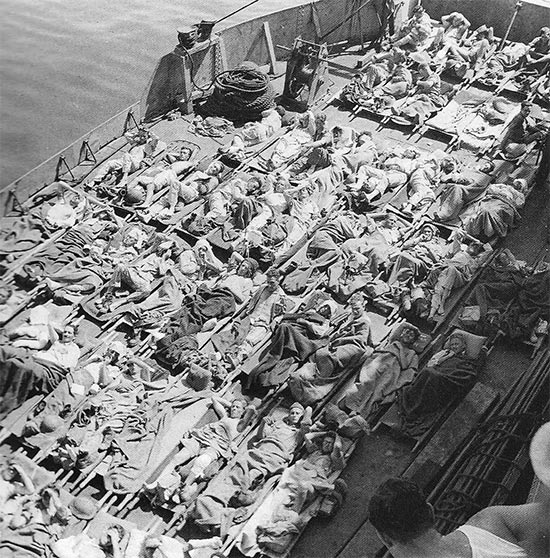
Vintage photo illustrating British casualties being evacuated by ship from Sicily. Initially, evacuation took place by sea to North Africa. During the first four days of the Sicily Campaign, casualties were evacuated either by returning troop carriers and LSTs to Tunisian or Algerian ports. It was only from 14 July 1943 that both US and British C-47 aircraft began to evacuate the many wounded from airfields around Gela, Licata, and eventually Agrigento. Evacuation by Hospital Ship only began on 15 July from Gela and from 16 July 1943 from Scoglitti, Sicily.
The “Cent Force” medical complement consisted of:
120th Medical Battalion (organic element of 45th Infantry Division)
54th Medical Battalion
1 Hospitalization Unit (organic element of 11th Field Hospital)
7 Surgical Teams (organic elements of 3d Auxiliary Surgical Group)
Units I and II pertaining to the 11th Field Hospital were attached to the “Dime Force” which unfortunately landed at the wrong beaches, around H + 6. They landed at Green Beach around 1230 hours, after debarking from LST 337. Casualties were relatively heavy on the Gela Beachhead as enemy counteraction was most violent. It would be 13 July 1943, before the Hospital was functioning at Gela. The withdrawal of the transports on 12 and 13 July halted evacuation from the beaches, but fortunately air evacuation from Ponte Olivo airfield began on 14 July. On 15 July a first Hospital Ship arrived to take the many battle casualties on board, while on 16 July 1943, the 400-bed 93d Evacuation Hospital set up and opened near Ponte Olivo to relieve the medical units operating on the island. Meanwhile Headquarters, together with Units I and II advanced further up to Pietraperzia were they set up their next Hospital.
The “Dime Force” medical complement consisted of:
1st Medical Battalion (organic element of 1st Infantry Division)
48th Armored Medical Battalion (organic element of 2d Armored Division)
2 Collecting-Clearing Companies (organic elements of 51st Medical Battalion)
2 Hospitalization Units (organic elements of 11th Field Hospital)
7 Surgical Teams ( organic elements 2d Auxiliary Surgical Group)
3 Surgical Teams (organic elements of 3d Auxiliary Surgical Group)
2 Ambulance Platoons (organic elements of 36th Ambulance Battalion)
After reaching the line marking the end of the amphibious operational phase, new field orders were issued for completing the conquest of Sicily. Two (2) Units of the 11th Field Hospital, together with the 15th Evacuation and the 93d Evacuation Hospitals came under II Corps control, while the remaining 11th Field Hospital Unit and the 11th Evacuation Hospital were to serve the 3 Divisions (2d Armored – 3d Infantry – 82d Airborne –ed) operating under the Provisional Corps commanded by Major General Geoffrey Keyes.
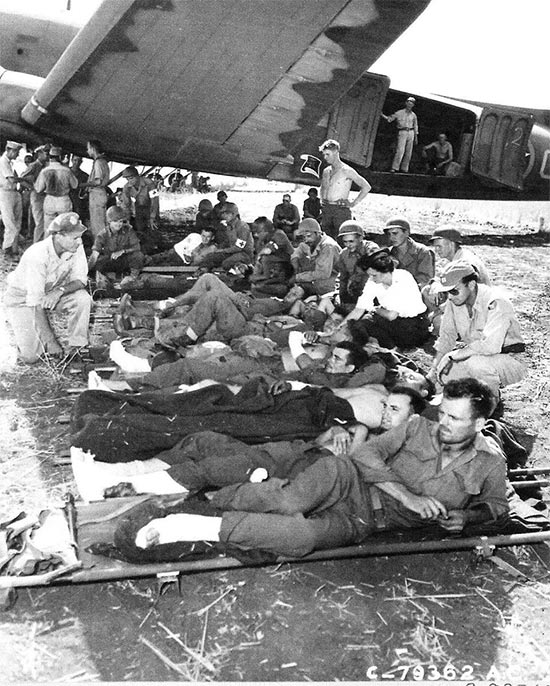
Vintage photo illustrating Allied litter patients waiting to board an evacuation plane that will take them to North Africa. Photo taken at the Agrigento airfield, Sicily, 25 July 1943. The first air evacuation flights left on 23 July. As the campaign moved, additional flights were organized departing from Castelvetrano, Palermo, and Termini.
Dental service in the Sicily Campaign would improve considerably as both the 10th and 11th Field Hospitals were equipped for prosthetic dental work. They each delegated a team consisting of 1 prosthetic operator and 2 assistants with their own equipment and tentage who were to visit all Corps troop units where cases were sufficient to justify the procedure. At the end of the island campaign, 2 DC Officers from the 11th Field were placed on DS to the 9th Infantry Division to catch up with dental work.
Following the initial landing operations, the 11th Field merely accepted all types of patients until it reached Nicosia, where the Hospital was reorganized into a three-Unit Surgical Hospital supporting the Divisional Clearing Stations. It was only after the move to Trapani, where at first only Unit I operated, that the installation functioned more like a Station Hospital. The area was more pleasant after bivouacking at Cesaro which was a place filled with dust, dysentery, and malaria. Trapani markets offered a rich variety of fruits such as melons, oranges, and grapes. Early September 1943, Termini became the final Staging Area in Sicily before crossing over to the Italian mainland. Passes were widely available, dances, USO shows, ARC shows, and an award ceremony with numerous Good Conduct Medals, closed the Sicily Campaign.
Stations in Sicily – 11th Field Hospital
Gela > 13 July 1943 (Headquarters + Unit I + II)
Vittoria > 14 July 1943 (Unit III)
Pietraperzia > 16 July 1943 5Headquarters + Unit I + II)
Castelvetrano > 21 July 1943 (Unit III)
Camporeale > 23 July 1943 (Unit III)
Palermo > 24 July 1943 (Unit III)
Collesano > 27 July 1943 (Headquarters + Unit I + II)
San Ambrogio > 30 July 1943 (Unit I)
San Ambrogio > 1 August 1943 (Unit II)
San Gracomo > 2 August 1943 (Unit II)
Nicosia > 3 August 1943 (Headquarters + Unit III)
San Stefano > 5 August 1943 (Unit I)
Cerami > 8 August 1943 (Unit III)
Cesaro > 12 August 1943 (Headquarters + Unit I)
Cesaro > 15 August 1943 (Unit III)
Randazzo > 16 August 1943 (Unit II)
Trapani > 16 August 1943 (Unit I)
Cesaro > 17 August 1943 (Unit II)
Trapani > 1 September 1943 (Headquarters + Unit II + III)
Termini > 3 September 1943 (Headquarters + Unit I + II + III)
The 11th Field Hospital re-assembled on 3 September 1943 and proceeded to their Staging Area at Termini. The organization left Termini at 0600 hours, 21 October 1943, and arrived in Messina around 1530, having traveled in Dukws (amphibious 2½-ton trucks –ed). The entire unit left their bivouac area in Messina, and crossed the Messina Straits aboard British LCI landing craft at 0600 in the morning of 22 October 1943, enroute for Italy.
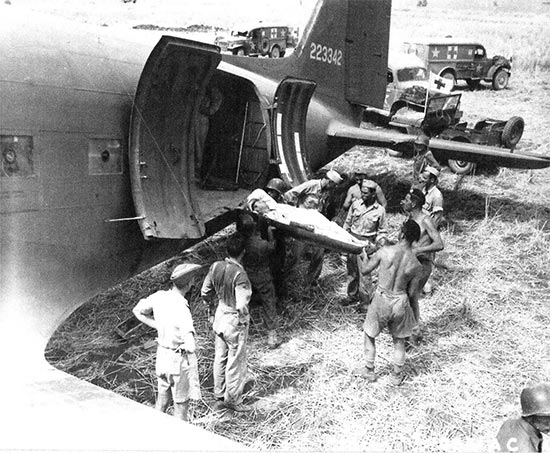
Another vintage photo illustrating a litter patient being carried aboard one of the C-47 aircraft, prior to his evacuation for further treatment in North Africa. Photo also taken at Agrigento, Sicily, 25 July 1943. The 802d MAETS was soon called in to provide medical attendants to accompany the casualties during flight.
Meanwhile, Lieutenant General Mark W. Clark’s Fifth United States Army (activated 5 January 1943 in French Morocco –ed) had been training in North Africa for six months in preparation for additional operations in the Mediterranean and by the end of the Sicily Campaign, a new operation against the Italian mainland had been approved. This was to be “Operation Avalanche”, contemplating Allied landings in Salerno with target date 9 September 1943. The aim of the operation was to tie down as many enemy forces as possible and acquire new bases for air attacks against German production and communications centers. Although on the troop list, some of the more experienced Evacuation and Field Hospitals (such as the 11th Field) were late in becoming operational. Indeed, the Hospital was inactive until the next phase of the Italian Campaign, October-November 1943, when it was assigned to II Corps
The 11th Field Hospital went through a first reorganization based on the new T/O & E 8-510 dated 28 September 1943.
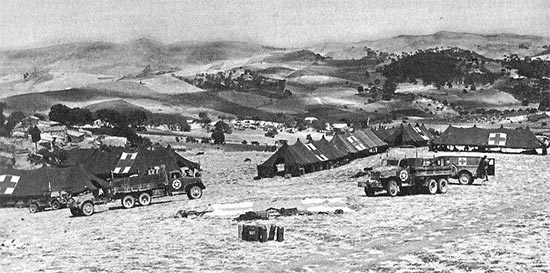
Vintage photo illustrating Unit II, 11th Field Hospital, set up near Nicosia, Sicily. Photo taken 5 August 1943.
Italy:
Following debarkation at Gallice, the 11th Field Hospital proceeded some 42 miles on to Gioia Tauro, Italy. From then on, further movements would bring the organization between 23 and 30 October to places like Nicastro, Belvedere, Pontecagnano, Atrapalda, Qualiano, and on 8 November 1943 Capua.
In addition to medical units organic to the Divisions committed, landings called for the following additional medical back up:
111th Medical Battalion (organic element of 36th Infantry Division)
120th Medical Battalion (organic element of 45th Infantry Division)
4th Medical Supply Depot
54th Medical Battalion
162d Medical Battalion
16th Evacuation Hospital
95th Evacuation Hospital
9 Surgical Teams (organic elements of 2d Auxiliary Surgical Group)
It must be noted that Field Hospitals were scheduled for later convoys to Italy. They were to land only after the Beachhead was secure, and no Nurses were to come before D + 2.
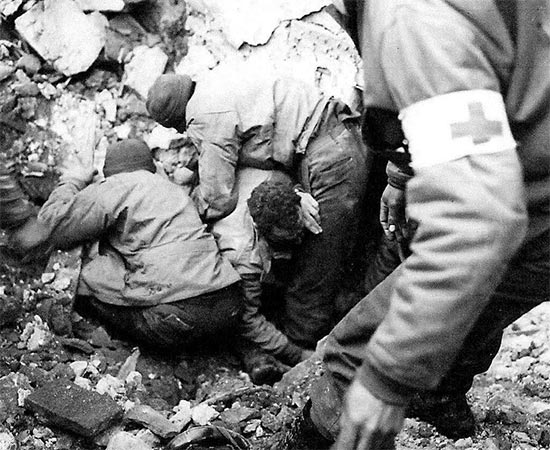
Vintage photo illustrating a GI buried in debris following an enemy bombing, being freed by medical personnel. Photo taken in Italy in January 1944.
As from 19 November 1943, four Surgical Teams and 1 Shock Team from the 2d Auxiliary Surgical Group were attached for duty with Unit III. They were to remain on duty until 24 December (only one such team remained until 9 January 1944 –ed). The Surgical Teams were on first call in surgery 8 hours each day, while the Shock Team were on duty for 12 hours each operating in two shifts. Between 19 November 1943 and 15 January 1944, a total of 132 patients were admitted for treatment by Unit III. During this same period 23 wounded patients were transferred and 35 died.
Climatic conditions were rigorous during the winter setup with continuous rain and severe wind storms causing quite some damage to the equipment. There were also two occasions on which enemy shells came down in the immediate vicinity of the Hospital causing damage to tents and equipment. One (1) Nurse was slightly injured and 2 EM received penetrating wounds from shell fragments. Patients received during this particular period were in severe shock as the cold weather delayed their removal from the place of wounding to the hospital site by several hours (sometimes taking between 12 and 30 hours –ed).
Some Statistics – 11th Field Hospital Unit III Report
132 patients – 35 deaths (19 November 1943 > 15 January 1944)
In mid-December, the II Corps Surgeon, Colonel L. Holmes Ginn, Jr. and II Corps Dental Surgeon, Lt. Colonel Gerald A. McCracken, organized a II Corps Prosthetic Dental Clinic and Laboratory with Dental Officers from both the 54th Medical Battalion and the 11th Field Hospital. The clinic was housed in a hospital ward tent complete with lighting, generator, tables, benches, and operating platforms. The remainder of the personnel provided by the 54th Medical Battalion and the 11th Field Hospital were supplemented by two Prosthetic Dental Teams consisting of 1 Dental Officer and 4 Technicians each, from the 2d Auxiliary Surgical Group.
During the afternoon of 31 December 1943, a wind and rain storm of considerable violence began, steadily increasing in rigor until about 1030 hours on 1 January 1944. During the night, strong winds blew down and rendered irreparable the Headquarters tent and caused considerable damage to the unit’s records and equipment. The loss of tentage for the whole organization amounted to 15 ward tents – 11 pyramidal tents – and 5 small wall tents. A great deal of equipment was also lost or damaged beyond repair. The situation rendered the three Units practically inactive for the next few days which were spent in requisitioning new equipment and making such repairs as were possible.
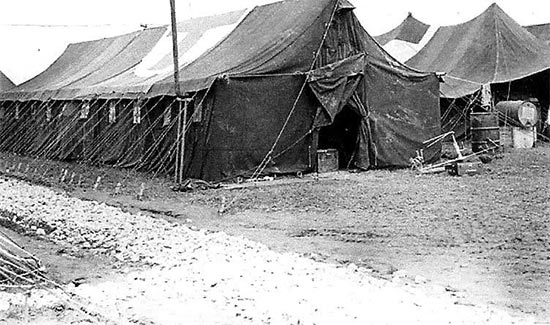
Vintage photo illustrating a typical Sectional Hospital Tent. The tent’s dimensions were 54 feet in length, 18 feet in width, and 12 feet in height, and the canvas was made of fire and mildew-resistant material.
As from 1 January 1944, the 11th Field Hospital operated as a four-unit component, with Headquarters, Units I – II – III operating at different sites. The unit strength stood at 20 Officers – 19 Nurses – and 206 Enlisted Men. Attached from the 2d Auxiliary Surgical Group were 15 Officers – 7 Nurses – and 13 EM. Attached from the II Corps Prosthetic Dental Clinic, then serving together with Unit III, were 4 Officers and 15 Enlisted Men.
On 14 January, the II Corps Prosthetic Dental Clinic was relieved of attachment to Unit III, and subsequently attached to Headquarters, 11th Field Hospital. The same day an American Red Cross Clubmobile Unit was attached to Headquarters. This ARC unit distributed donuts and coffee to the various installations of II Corps and Fifth United States Army stationed in the vicinity, working from the 11th Field Hospital Headquarters as a base. The Clubmobile consisted at various times of 5 to 8 civilian ARC workers supplemented by 7 EM.
On 17 January 1944, Unit III having transferred all its patients moved from their station near Presenza to take up a position one mile south of San Pietro receiving only surgical cases as before. On 18 January, Unit II was ordered to move forward. However, there were at that time 17 non-transportable cases still present. So, when Unit II moved and took up a new station two miles southeast of San Pietro, a Holding Hospital was sent to relieve them at their old area. This new type of organization was in operation from 18 January to 27 January 1944 and was composed of 1 Officer and 2 Nurses from the own organization, and 3 Officers and 2 Nurses from the 2d Auxiliary Surgical Group. The Enlisted personnel consisted of 12 EM from the 11th Field Hospital and 3 Surgical Technicians from the 2d Auxiliary Surgical Group. Repeated experimentation during the Sicily Campaign had shown this to be the most satisfactory distribution for this type of unit with the personnel available. On 27 January, the Holding Hospital for Unit II returned to Headquarters.
With the exception of this short period, all Hospital Units were active, except Unit I which closed down and went into bivouac on 23 January 1944. Each Unit now actively supported a Divisional Clearing Station. Unit I worked in conjunction with the Clearing Company of the 54th Medical Battalion; Unit II supported the Clearing Company of the 109th Medical Battalion (34th Infantry Division); and Unit III operated together with the Clearing Company of the 111th Medical Battalion (36th Infantry Division). In their positions, both Unit II and III were located within range of enemy artillery fire, which on several occasions, hit close to the hospital area.
Between 18 January 1944 and 19 February 1944, Unit II received a total 814 admissions. The number of patients included Free French – British – Italian soldiers – as well as civilians. Thirty-six (36) deaths were registered. When the patient census was high, an extra pyramidal tent was put up and Unit I was called in for assistance. Three (3) extra ANC Officers from the 94th Evacuation Hospital were sent to the unit on DS from 2 February to 12 February 1944. Eight (8) of the patients treated suffered gas gangrene, but only 4 recovered. On 31 January 1944, the unit received 9 Enlisted Men as replacements from Personnel Center No. 6, 2d Replacement Depot.
Some Statistics – 11th Field Hospital Unit II Report
133 patients – 36 deaths (18 January 1944 > 19 February 1944)
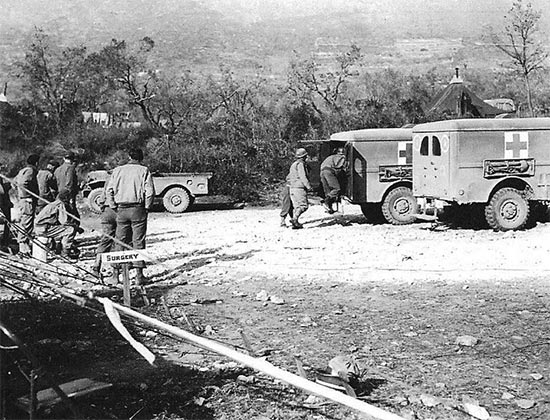
Vintage photo illustrating patients coming in by 3/4-ton ambulance. Photo taken in the vicinity of Venafro, Italy, February 1944, where Unit I, 11th Field Hospital, was set up.
On 6 February, on account of an increasing number of incoming patients, another 3 Nurses were placed on TD with the organization.
On 8 February 1944, a 40mm HE AAA shell exploded over the Officers’ area of Unit II, destroying an entire pyramidal tent and a small wall tent. Fortunately, no personnel were injured. Headquarters left their station in the vicinity of San Vairano by motor convoy on 9 February to take up a new position some 2 miles southwest of Venafro. At the same time, Unit I left Minturno to join the Headquarters convoy and proceeded with them to the new area.
Heavy rains continued periodically severely hampering movement which necessitated a great deal of extra work in the preparation and maintenance of installation sites for both Headquarters and the active Units. Elements pertaining to the 19th Engineer Combat Regiment were therefore called upon to lay gravel for roads and walks, and the interiors of tents, and to build drainage ditches, while the own personnel tried avoiding spoilage of supplies and equipment by mud and water. As Unit II had nearly reached its capacity of patients, it was decided to send Unit I, complete, to operate independently in the same area. Unit I moved to the new site on 10 February, and closed on 16 February 1944. Headquarters left Venafro by motor convoy on 16 February to open at a new site some two and one-half miles south of Ailano, where they were joined by Unit I which had recently proceeded from the San Pietro area. The Ailano site was intended as a bivouac and a training area for units attached to II Corps, and the 11th Field’s mission was to establish a provisional Station Hospital to care for troops in this area. This change in function did generate a great deal of reorganization of equipment, since the Hospital had not functioned as a single unit from the early days of the Sicily Campaign. As the other Units came, Unit II on 25 February and Unit III on 28 February, they were to add their facilities to those of Unit I, until a completely staffed and equipped 400-bed Station Hospital, housed in tentage, was operating almost at full capacity. Headquarters and Company D, Clearing Company, 54th Medical Battalion, were set up together so that the two organizations used a combined Admission and Disposition Department in order to coordinate their hospitalization policy.
On 17 February 1944, the organization lost 1 ANC Officer who was transferred to the Detachment of Patients, 23d General Hospital. She was replaced by a new Nurse who joined from the 7th Station Hospital. On 27 February 1944, two more ANC Officers were placed on TD with the 11th Field to supplement their nursing staff. Pursuant to current orders from Headquarters, NATOUSA, cancelling all overstrength, 26 Enlisted Men were transferred in grade to Personnel Center No. 6, PBS (this brought the Enlisted strength down to 188 –ed).
Total admissions for Units II and III for the period of February 1944 numbered 140, while 50 deaths were registered.
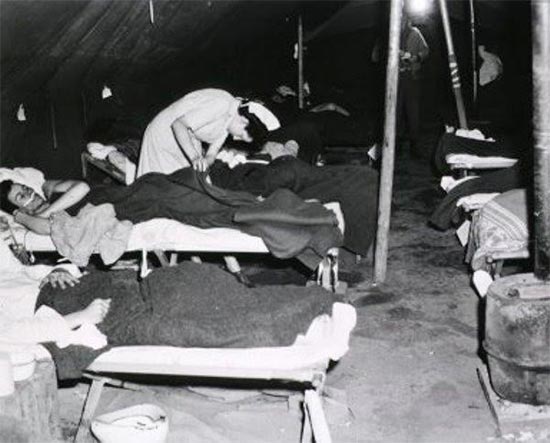
Vintage photo illustrating a Nurse at work in a Ward Tent. Photo taken March 1944, at Bucciano, Italy, where the entire 11th Field Hospital was established between 9 and 11 March 1944.
Early March, the number of patients admitted under the provisional Station Hospital type of operation was of course considerably larger with patients being admitted at the rate of approximately 65 per day, with the largest number of cases received at one time reaching 425 on 6 March 1944. Since the majority were medical cases, the influx did not cause undue strain on the organization’s facilities and personnel. Following receipt of new instructions, the organization moved by motor convoy to a new destination in three echelons, traveling on 9 – 10 – 11 March and reaching the new site located about two miles east of Bucciano, a total distance of 40 miles. A total of 139 patients were moved to Bucciano by ambulances from the 54th Medical Battalion on 10 March. On 12 March, just as the Hospital had set up and began receiving patients, a severe wind and rain storm broke and persisted with increased violence until 1000 hours the following day. Between 0600 and 0800, 13 March 1944, all patients were evacuated via 54th Medical Battalion ambulances to the 73d and the 74th Station Hospitals. The storm caused indeed considerable damage rendering the Hospital completely inactive for a period of five days. Loss of tentage amounted to 25 ward tents – 11 pyramidal tents – 1 large wall tent and 1 small wall tent. A large number of folding cots, mattresses, blankets, sheets, pillows, light bulbs and other ward equipment was also lost.
During March, various changes in Officer personnel took place, with Officers leaving the organization to join other medical units, and receipt of new assignments and replacements. On 18 March replacements for supplies lost having been received, the organization was once more able to accept patients as a Station Hospital. Minor repairs continued to be necessary, as severe winds continued to blow unceasingly.
On 25 March 1944, Major Claude D. Bonham, MC, Major Joseph E. Barnard, MC, and First Lieutenant Cordelia E. Cook, ANC, received the Bronze Star Medal from Major General Geoffrey Keyes, CG, II Corps for “meritorious service in direct support of combat operations”.
During the evening of 25 March the wind began to blow heavily again reaching gale proportions by next morning. Consequently, all patients were safely evacuated to the 64th General Hospital during the morning. At about 1030, a single wind blast leveled approximately a quarter of all tents still standing including a recreation tent where religious services were being held. Several personnel were slightly injured. The loss of tentage on this occasion amounted to 37 pyramidal tents – 19 ward tents – 11 small wall tents – 3 large wall tents – and 1 storage tent. Because of above loss it became necessary to close down the installation awaiting the arrival of new equipment. The organization left Bucciano by truck on the morning of 31 March setting up its bivouac one mile south of Nocelleto the same day. The Station Hospital function was now discontinued since all II Corps units had gone back into action.
On 2 April 1944, some promotions took place among ANC Officers.
Following this period, and starting 10 April, the organization went into direct support of the Clearing Stations set up by the 310th (85th Infantry Division) and 313th Medical Battalions (88th Infantry Division). For some five to six weeks prior to the launching of the drive to Rome, set for 11 May 1944, Fifth US Army medical units performed only routine functions with time for replacing equipment and material losses, while medical personnel trained with their respective Divisions. Before being able to move again it was necessary to break down the organizational equipment once more into three components which occupied the earlier part of April. This was conceived as something of a rest period.
On 11 April, the entire dental staff of the 11th Field consisting of 2 Officers and 2 Technicians, was placed on DS of unknown duration with the Fifth United States Army Rest Center in Caserta.
Some Statistics – 11th Field Hospital Headquarters Report
21 patients – 4 deaths (11 April 1944 > 30 April 1944)
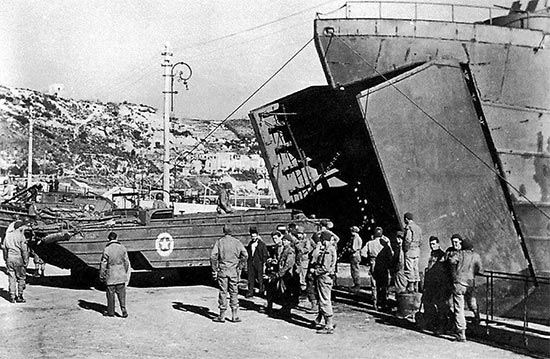
Vintage photo illustrating DUKWs (2 1/2-ton amphibious trucks) leaving an LST. Photo taken at the Port of Naples, Italy, July 1944.
On 20 April 1944, another award ceremony took place. Major Ernest L. Boylen, MC; Technician 3d Grade Maynard O. Stromberg, MD; Technician 4th Grade Eugene A. Fletcher, MD; Corporal David D. Behan, MD; and Private First Class Theodore W. Weibel, MD, received the Bronze Star Medal from Major General Geoffrey Keyes, CG, II Corps, for “meritorious service in direct support of combat operations”. At the same ceremony, Units I and II, 11th Field Hospital, received the “Fifth United States Army Plaque and Clasp” awarded to units having performed “exceptionally meritorious services not in actual combat”.
More Officer changes were in effect on 24 and 28 April 1944, involving replacements received from the Personnel Center No. 9, 2d Replacement Depot. Some Officers were relieved and transferred to the 16th Evacuation Hospital.
The number of admissions for the month of May 1944 totaled 276. Eight deaths prior to operation and 36 deaths following operation were registered.
As planned, the Allied Armies in Italy began their successful attempt to break the stalemate which had developed and persisted along the entire front since the advance was stopped at Monte Cassino. As a result, Unit II was sent to a site four miles east of Minturno to support the 313th Medical Battalion Clearing Station. On 18 May, Headquarters and Unit III left the area of Nocelleto by motor convoy arriving at another installation site about one mile south of Minturno. Unit I had meanwhile been supporting the 85th Infantry Division Clearing Station in the vicinity of Cellole, some five miles southeast of the Garigliano crossing, where high numbers of casualties were received. They reached a record 544 during a period of 24 hours on 12 May, while another 500 admissions came in on 13 May. This warranted extra assistance in the form of Unit III which joined in support. Through 14 May, weapon carriers and cargo / personnel trucks evacuated the walking wounded while two Platoons of the 54th Medical Battalion also assisted with the evacuation.
Stations in Italy – 11th Field Hospital
San Variano > 17 November 1943 (Unit III)
Presenza > 17 November 1943 (Unit III)
Pietramelera > 23 November 1943 (Unit I)
San Variano > 29 December 1943 (Headquarters)
Presenzano > 29 December 1943 (Unit II)
Minturno > 30 December 1943 (Unit I)
Presanzano > 1 January 1944 ( Unit I + II)
San Pietro > 8 January 1944 Unit II)
San Pietro > 17 January 1944 (Unit III)
San Pietro > 18 January 1944 (Unit II)
Minturno > 23 January 1944 (Unit I)
San Variano > 27 January 1944 (Unit II)
San Variano > 1 February 1944 (Headquarters)
San Pietro > 1 February 1944 (Unit II + III)
Venafro > 9 February 1944 (Headquarters + Unit I)
Venafro > 10 February 1944 (Unit I)
San Pietro > 10 February 1044 (Unit I)
Ailano > 16 February 1944 (Headquarters + Unit I)
Ailano > 16 February 1944 (Unit I)
Ailano > 25 February 1944 (Unit II)
Ailano > 29 February 1944 (Unit III)
Piedmonte > 3 March 1944 (Unit II + III)
Bucciano > 9-11 March 1944 (Headquarters + Units I + II + III)
Nocelleto > 31 March 1944 (Headquarters + Units II + III)
Mondragone > 10 April 1944 (Unit I)
Mondragone > 1 May 1944 (Unit I)
Minturno > 16 May 1944 (Unit II)
Minturno > 18 May 1944 (Headquarters + Unit III)
Formia > 20 May 1944 + Unit II)
Itri > 21 May 1944 (Unit II)
Monte San Biagio > 24 May 1944 (Headquarters + Unit I + III)
Priverno > 27 May 1944 (Unit I)
Priverno > 30 May 1944 (Headquarters + Unit II + III)
Cisterna > 2 June 1944 (Unit I)
Valmontone > 3 June 1944 (Unit I)
Cisterna > 6 June 1944 (Headquarters + Unit II + III)
Dogana > 13 June 1944 (Headquarters + Unit II)
Dogana > 14 June 1944 (Unit I)
Grosseto > 16 June 1944 (Unit II)
Grosseto > 17 June 1944 (Unit III)
Grosseto > 18 June 1944 (Headquarters + Unit I)
Follonica > 24 June 1944 (Unit I)
Follonica > 25 June 1944 (Headquarters + Unit II)
Campiglia > 26 June 1944 (Unit II)
Tarquinia > 3 July 1944 (Headquarters + Unit I + II + III)
Civitavecchia > 5 July 1944 (Headquarters + all Units) movement by water to Naples
Naples > 7 july 1944 (Headquarters + Unit Unit I + II + III)
Sparanise > 8 July 1944 (Headquarters + all Units)
Qualiano > 26 July 1944 – 9 August 1944 (Headquarters + all Units) movement to staging area
On 12 and 15 May 1944 respectively, Major Claude D. Bonham, MC and Major Ernest L. Boylen, MC, Commanding Officers of Hospitalization Units III and I, both of whom had been with the organization since activation, were transferred to the Detachment of Patients, 36th General Hospital.
The advance up the Italian Peninsula was extremely rapid and the Units were forced to leapfrog each other at very short intervals, remaining in one location only a few days. On 20 May 1944, Unit II moved to one-half mile east of Formia, leaving a Holding Company to care for their remaining patients. The Unit only bivouacked overnight at Formia and already left the next day to arrive at a new site situated three miles north of Itri where they set up and began receiving patients. On 24 May, Headquarters plus Unit III left Minturno and moved to a new location one-half mile east of Monte San Biagio. The same day, Unit I left Mondragone and joined Headquarters and Unit III near Monte San Biagio to support the 310th Medical Battalion Clearing Station. On 27 May 1944, Unit I left Headquarters and moved to another site located only two miles south of Priverno, again in support of the 313th Medical Battalion. There had been a scare in May, when the organization was alerted for movement to the Anzio Beachhead, but orders were cancelled.
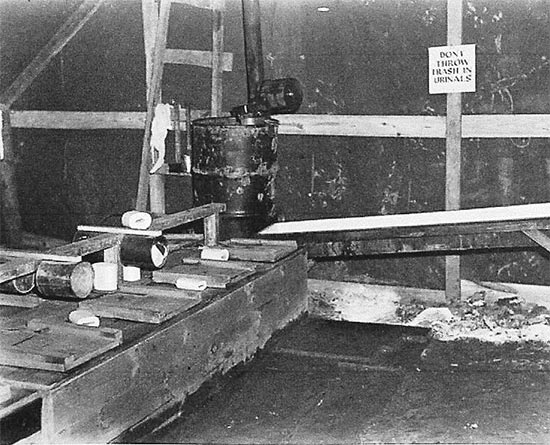
Vintage photo illustrating “indoor” latrines under canvas.
On 28 May 1944, pursuant written orders from Headquarters, Fifth US Army, the 11th Field Hospital was relieved and attached to IV Corps for further operations. The 10th Field Hospital relieved the 11th Field and sent its units to support the 85th and 88th Infantry Division Clearing Stations. On 30 May, Headquarters joined Unit I near Priverno. As a consequence of the Hospital’s relief from II corps, the ARC Clubmobile Unit, was no longer attached to the organization.
Some Statistics – 11th Field Hospital Headquarters Report
276 patients – 44 deaths (1 May 1944 > 31 May 1944)
When Unit I left their bivouac area to proceed to a new location one and one-half miles south of Valmontone, it was attached to the 10th Field Hospital from 1 June up to 11 June 1944. Together they left the area for a position near Labico, where they established a hospital and received many surgical patients for the duration of this TD period.
Field Hospitals found it almost impossible to move with the same frequency as the Clearing Stations they supported, not only because of the need for post-operative care to their patients, but also because of the inadequacy of their limited organic transportation. Therefore it was decided to give every Field Hospital 6 additional 2½-ton trucks in June, even reaching 10 in all, but even this number was sufficient to move only a single Unit at the time.
Air Evacuation – by 802d MAETS + 807th MAETS to Italy
Priverno > 26 May 1944 – 31 August 1944 (356 patients) to Naples
Grosseto > 26 May 1944 – 31 August 1944 (1,397 patients) to Naples
Follonica > 26 May 1944 – 31 August 1944 (384 patients) to Naples
Follonica > 26 May 1944 – 31 August 1944 (4,600 patients) to Rome
Tarquinia > 26 May 1944 – 31 August 1944 (245 patients) to Naples
The rest of the organization ceased operations in support of the drive on Rome during which time it was relieved from attachment to IV Corps and reverted to Fifth United States Army control. On 6 June 1944, Headquarters, with Units II and III, left the Priverno area for a bivouac one mile northeast of Cisterna. By 11 June, Unit I was relieved from TD with the 10th Field and reverted to control of Headquarters, 11th Field Hospital. On 13 June, orders were received ordering the organization to be re-attached to IV Corps, and instructions followed to move to another location one mile southeast of Dogana, traveling a distance of over one hundred and fifty miles, where they were joined the next day by Unit I. On 16 June 1944, Unit II left the Dogana area to set up four and one-half miles south of Grosseto. Unit III followed one day later, while Headquarters and Unit I arrived at this site on 18 June. Unit III arrived at the bivouac area to set up another hospital some six miles north of Grosseto. Unit II was unable to move because of the large number of non-transportable cases still remaining. It eventually moved on 25 June. On 26 June 1944, Unit II left Follonica where it had set up 24 June, for a new location four and one-half mile south of Campiglia. Orders were received 28 June relieving the Unit from IV Corps with reversion to control of Fifth US Army.
Some Statistics – 11th Field Hospital Headquarters Report
118 patients – 15 deaths (1 June 1944 > 30 June 1944)
On 1 July 1944, Unit II having closed the hospital at Campiglia, proceeded to a new area situated two and one-half miles north of Follonica where they joined Headquarters and Unit I. On 3 July, Headquarters plus Units I and II left the area for a new bivouac six miles south of Tarquinia to prepare for movement by water. The entire organization, with the exception of a small Detachment consisting of 3 Officers – 18 Nurses – and 28 Enlisted Men, moved by motor convoy to Civitavecchia where they boarded the S/S “Haym Salomon” (Liberty ship launched 17 May 1943 –ed) for movement to Naples, Italy. The unit supplies and equipment went aboard the same ship. She left on 6 July and anchored in Naples harbor the following day. The organization was allowed to debark 8 July moving by truck to a bivouac area four miles east of Sparanise. The Detachment left behind at Tarquinia had meanwhile moved overland to Sparanise arriving there on the evening of 6 July. They were considered to be the advance party and were therefore able to prepare the area for occupation before arrival of the balance of the organization.
On 7 July 1944, the 11th Field Hospital was officially relieved from assignment to Fifth United States Army and was now assigned to Allied Force Headquarters (AF –ed), attached to the Services of Supply (SOS) for supply and administration, to Seventh United States Army for planning and training, and to VI Corps for a special tactical mission.
On 19 July, Unit II, minus 6 ANC Officers, were further attached to the 45th Infantry Division for duty and administration for the initial portion of the coming new operation. On 21 July, the 6 Nurses normally assigned to Unit II were placed on TD with the 93d Evacuation Hospital. On 22 July 1944, Headquarters and Units I and III, minus 12 ANC Officers, were similarly attached to the 36th Infantry Division. Some changes including transfers and replacements took place during this period.
On 26 July 1944, the organization left Sparanise moving to a Staging Area some two and one-half miles northwest of Qualiano. New ANC Officers who had recently joined the organization were immediately placed on temporary duty with the 11th Evacuation Hospital. Meanwhile the unit’s supplies and equipment were being loaded on trucks and taken to Naples P/E, Italy. While stationed in Qualiano, three-day passes were issued and daily passes to Naples seemed always available.
On 8 August 1944, Unit II left the Qualiano area for Embarkation Point No. 7, where they got on board of the USS “Barnett” APA-5 (transport, built in 1928 in the United Kingdom, purchased by the US Navy in August 1940, converted and commissioned 25 September 1940 –ed), which left Naples the following day.
On 9 August, the remainder of the organization, Headquarters + Units I + III, with the exception of a few Officers assigned as security personnel to various ships of the convoy, and the majority of drivers who were assigned with their vehicles to supply ships, left the Staging Area and proceeded to an Assembly Area. On 10 August they went by truck to Naples and boarded the USS “General George O. Squier” AP-130 (transport, launched 11 November 1942, and commissioned 2 October 1943 –ed) during the afternoon. Above ships were to join Task Force 87, a convoy of 855 ships sailing for Southern France during “Operation Dragoon”. The ships left Naples, Italy, on 13 August 1944.
Southern France:
The Invasion of Southern France, “Operation Dragoon”, was far different from the Sicily landings. It was easier and inland movement was much quicker. The most serious incident was the destruction of an LST carrying troops and equipment belonging to the 36th Infantry Division, by a radio-controlled bomb dropped by the Luftwaffe.
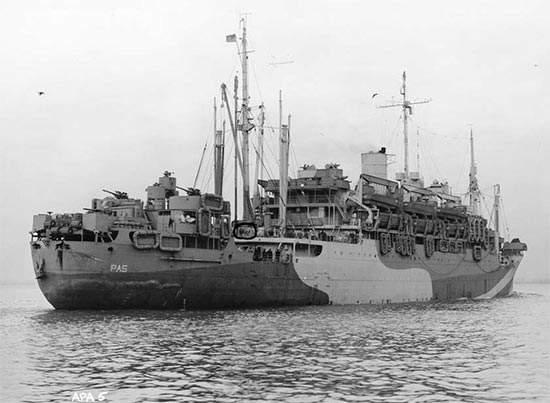
Vintage photo illustrating USAT “Barnett”, APA-5. Unit II, 11th Field Hospital, boarded the ship on 9 August 1944, which would set sail for Southern France, leaving the Port of Naples, Italy, on 13 August, in order to participate in Operation “Dragoon”.
Units pertaining to the 10th and 11th Field Hospitals attached to “Delta Force” both landed around noon of D-Day, but neither went into operation on 15 August 1944. While Unit II of the 10th Field received their first patients at Plan-de-la-Tour on 17 August, Unit II of the 11th Field Hospital did not operate at all during the beach phase. The 93d Evacuation Hospital however did land near Sainte-Maxime at H + 4, and opened at Plan-de-la-Tour the same day. Expansion inland was quite rapid with Divisional Clearing Stations opening quickly.
The “Delta Force” medical complement consisted of:
120th Medical Battalion (organic element of 45th Infantry Division)
58th Medical Battalion, Separate (388th Med Coll Co + 389th Med Coll Co + 390th Med Coll Co + 514th Med Clr Co)
2d Platoon (organic element of 616th Medical Clearing Company)
Hospitalization Unit II (organic element of 10th Field Hospital)
Hospitalization Unit II (organic element of 11th Field Hospital)
9 Surgical Teams (organic elements 2d Auxiliary Surgical Group)
93d Evacuation Hospital
“Camel Force” landed on three separate beaches east of Saint-Raphaël. Litter sections of the organic Medical Collecting Companies landed with their Battalion Aid Stations of the assault troops. By H + 8, all personnel of the 111th Medical Battalion were ashore, although the equipment of the Medical Clearing Company was not unloaded until the evening of 18 August. By that time, the fighting was so far inland, that the Divisional Clearing Station was first established at Le Muy, some fifteen miles from the beach, in the early afternoon of 17 August 1944. It was able to move further inland the following day, to a new site near Draguignan.
The two Units of the 11th Field together with the 11th Evacuation Hospital landed together around 1900 hours, going into bivouac near their landing area. One Unit would follow the 36th Infantry Division to Le Muy, while the other Unit was to join the other Clearing Station set up at Draguignan on 18 August.
The “Camel Force” medical complement consisted of:
111th Medical Battalion (organic element of 36th Infantry Division)
56th Medical Battalion, Separate (885th Med Coll Co + 886th Med Coll Co + 887th Med Coll Co + 891st Med Clr Co)
164th Medical Battalion, Separate (675th Med Coll Co + 676th Med Coll Co + 677th Med Coll Co + 638th Med Clr Co)
1st Platoon (organic element of 638th Medical Clearing Company)
Hospitalization Units I + III (organic elements of 11th Field Hospital)
7 Surgical Teams (organic elements of 2d Auxiliary Surgical Group)
11th Evacuation Hospital
The convoy sailed on 13 August 1944 and after a comparatively uneventful voyage, reached a RV point off the south coast of France on the morning of D-Day, 15 August 1944.
Unit II debarked three miles southeast of Sainte-Maxime, France, at 1220 hours; Headquarters and Unit I and III landed at Drammont, at 1900 hours. Both groups dug in and went into bivouac until a large enough Beachhead could be made to enable them to function properly.
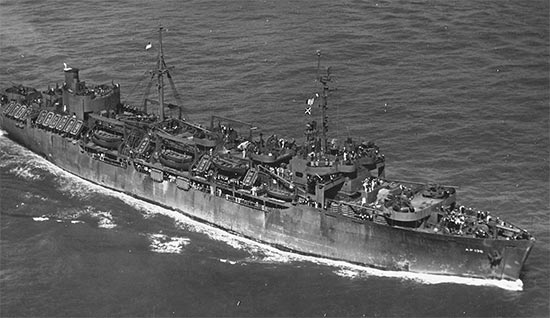
Vintage photo illustrating USAT “George O. Squier”, AP-130, which would carry Headquarters and Units I + III to Southern France. The transport departed the Port of Naples, Italy, on 13 August 1944, to rendezvous with the TF # 87 convoy, which was to participate in Operation “Dragoon”, the Invasion of Southern France set for 15 August 1944.
On 17 August 1944, Headquarters plus Units I and III left Drammont for a new location at one and one-half miles east / southeast of Le Muy, where Unit III set up the organization’s first Hospital on French soil. On the same date, Unit II left their site two miles south of Sainte-Maxime for a new bivouac area situated at one mile north of Sainte-Maxime. On 18 August 1944, Headquarters and Unit I left Le Muy, proceeding to Draguignan where Headquarters set up within the town and Unit I set up another 50-bed Hospital one-fourth mile west.
On 19 August 1944, the Nurses complement (traveling aboard USAHS “Ernest Hinds” –ed) finally rejoined the 11th Field and those ANC Officers assigned to Unit II were placed on temporary duty with the 45th Infantry Division. On 20 August, Unit II left the Sainte-Maxime area for another site some three and one-half miles east of Saint-Martin, and Unit III, having closed the hospital at Le Muy, joined Headquarters at Draguignan.
One of the attached medical personnel outfits pertaining to the 2d Auxiliary Surgical Group was Surgical Team # 12, under command of Major Howard Bos and consisting of Major Frank Norris, Captain Ross Hobler, First Lieutenant Frances Miernecke, Technician 4th Grade Ernest Tignanelli and Technician 5th Grade Frank Kempner.
On 21 August, Headquarters and Units I and III were relieved from attachment to the 36th Infantry Division and reverted to VI Corps control. Unit II had meanwhile also been released by the 45th Infantry Division and reverted to control of Headquarters, 11th Field Hospital on the same day. Also on 21 August 1944, Unit II left Saint-Martin for a new installation site one mile north of Saint-Paul-lès-Durance, while Unit III left Draguignan to proceed to Les Bons-Enfants, to set up once more. On the following day, Unit I closed their installation at Draguignan and moved to Aspres-sur-Buëch where they bivouacked overnight. They completed the trip the following day arriving at a place situated one-half mile east / southeast of Crest, where they would operate as an Evacuation Hospital for three days, since there was no evacuation area nearer than the Beachhead area, which was now 200 miles distant by highway. The total distance traveled reached over two hundred miles. Headquarters joined Unit at Crest somewhat later during the day. They bivouacked with Unit III at Les Bons-Enfants and reached Crest the following day. On 25 August, Unit III closed their Hospital, and also moved to the Crest area for bivouac.
Some Statistics – 11th Field Hospital Headquarters Report
219 patients – 18 deaths (15 August 1944 > 31 August 1944)
The area adjacent to the hospital site was periodically subjected to enemy shelling on 24 and 26 August and personnel were forced to dig in for protection. The high number of patients admitted at this area taxed the organization’s facilities to the utmost, and the long supply lines made it extremely difficult to obtain essential medical supplies. Nevertheless, foresight and previous experience enabled the Hospital to overcome these difficulties and continue functioning at maximum efficiency until the crisis was over.
On 26 August 1944, Unit II left Saint-Paul-lès-Durance and moved by motor convoy to a location one-half mile north of Montrond. On the same date, Captain Fred T. Burick, MC, one of the first Officers to join the 11th Field Hospital, was relieved from assignment and duty, and transferred to the 2d Auxiliary Surgical Group.
From 22 to 31 August 1944, the Divisional Clearing Station admitted 2174 patients (of whom 840 were battle casualties and 411 enemy PWs –ed). The patient census rose to 322 on 27 August alone. The largest number of PW patients was received on 29 and 30 August 1944, totaling 120 and 191, respectively.
During the whole of the month of September, Seventh United States Army forces advanced through France with great rapidity, and all three Units were either operating or moving during the entire period. Unit I and III continued to support Clearing Stations of the 36th Infantry Division, while Unit II serviced the 45th Infantry Division. The 10th Field Hospital and the 11th Field now operating in 50-bed units rather than the 100-bed units used in Italy, served throughout the campaign as a kind of forward Surgical Hospital, remaining either close to, or moving with the Divisional Clearing Stations. They were often backed up as closely as transportation and available installation sites permitted by the 400-bed Evacuation Hospitals and later by their larger counterparts. During the rapid advance, field units were often far ahead of any Evacuation Hospital support. On these occasions, Clearing Platoons of the 56th Medical Battalion were brought in to increase bed capacity.
Some Statistics – 11th Field Hospital Headquarters Report
355 patients – 42 deaths (1 September 1944 > 30 September 1944)
Movement through Southern France up to Alsace was swift but not without problems. As the entire front moved fast, it became difficult for the medical units involved to follow the Divisional Clearing Stations they were supposed to support. Moreover regular shortages of gasoline, food, and supplies were often hampering progress and comfort of the hospital units. One big problem was the non-availability of trucks required to transport personnel, supplies, and equipment. During fall and winter, climatic conditions affected movement and bivouacking. Food was cold, tents were cold, and personnel were also cold. Consequently, the campaign began to slow down and a winter stalemate set in. One of the priorities was to look for new sites containing empty or abandoned buildings, which would provide some more appropriate shelter for the heavy rains.

Partial map illustrating the advance and forward set up of Seventh United States Army Hospitals and Medical Supply Dumps in September 1944. In this period of time, Unit I, 11th Field Hospital was established near Saulx, in the Moselle region, France.
On 2 September 1944, Unit III left Crest and moved one-half mile southwest of Diemoz, France, to set up a temporary hospital. On the same date Unit II left the Morestel area and set up one mile north of Pont d’Ain, leaving a Holding Unit behind to care for the remaining patients. On 4 September, Headquarters left the Crest area and after traveling over one hundred thirty-two miles in convoy stopped overnight for bivouacking. The next day they arrived at a new location in Attignat, some hundred sixty-five miles from Crest. Meanwhile the progress made had gone too swiftly for Unit III to be effective at the Diemoz location. They consequently discontinued operations and joined Headquarters at Attignat, where they spent the night before moving on to one mile west of Poligny, where they only remained until 9 September, moving again to a new location near Quingey. Two days later Unit III were on the move once more, now traveling to Fretigney where they finally set up and began receiving patients in large numbers, including many Prisoners of War.
Meanwhile Unit II were facing the same difficulty. On 5 September they left Pont d’Ain, moving to Cesancey, where they bivouacked. The next day they moved again to one-half mile southeast of Chantrans, where holding Unit II joined them from Morestel. They stopped at Chantrans for two days before moving to a place one mile west of Etalans on 8 September 1944. On 11 September Unit II were moving again to one-half mile west of Baume-les-Dames.
Headquarters left Attignat on 9 September for Le Chay, where they arrived the same day. They were joined there two days later by Unit I which had moved up from Crest after having evacuated all their patients. The Unit III CO, Captain Lewell S. Walker, Jr., MC was promoted to Major during the same month.
On 15 September 1944, Unit I left their bivouac near Le Chay and traveled two miles south of Saulx where they pitched their tents for receiving patients. On 18 September, Headquarters left Le Chay and moved to one-fourth mile northwest of Luxeuil-les-Bains which had been captured the day before. On 21 September, Unit I closed their installations and moved forward to a new location south of Plombières-les-Bains. The same day, Unit II left Baume-les-Dames for Bains-les-Bains. On 22 September 1944, Unit III closed their Hospital at Fretigney and also moved to Plombières-les-Bains, where they set up in the vicinity of Unit I, and bivouacked. 25 September 1944, Unit III left their bivouac area and moved to a new location one-half mile south of Eloyes, where, because of the tactical situation, large numbers of patients were received almost at once. The following morning Unit III was subjected to enemy shellfire. Three shells landed in the installation area causing extensive damage to the unit’s tentage, but fortunately no personnel were injured. On 27 September, Unit II moved on to Epinal in the 45th Infantry Division sector, where they set up again. On 29 September, Headquarters also moved and proceeded to a location one mile east of Eloyes.
30 September 1944, new orders were received, dated 16 August 1944, relieving the 11th Field Hospital from assignment to Allied Force Headquarters and re-assigning them to Seventh US Army. On the same date, 6 ANC Officers of the 46th General Hospital and 17 Enlisted Men of the 56th Medical Battalion, were placed on temporary duty with the 11th Field Hospital to help care for the exceptional large number of patients being received.
October 1944 saw the 11th Field surpass all previous records for admissions, both by the individual Units, and as an organization. During this period there was extremely heavy fighting in the Vosges Mountains in the sectors of the 36th and 45th Infantry Divisions, but since such advances as were made were largely local, Units II and III retained their respective positions during October (Unit II were two miles east of Epinal, and Unit III one-half mile south of Eloyes –ed). On 7 October, Unit I closed their Hospital at Plombières and moved by motor convoy to Eloyes where they remained in bivouac. In order to handle the ever-increasing flow of wounded, groups of Nurses and EM from other organizations were placed on temporary duty with Units II and III at various times during the month. Changes in Officer personnel continued during this period with transfers and incoming replacements.
On 26 October, the 11th Field Hospital underwent a second reorganization based on a new issue of T/O & E 8-510 dated 31 August 1944. The most significant change in personnel was the reduction in the number of Basic Non-Specialist Enlisted Men from 14 to 9.
As of 0001 hours, 1 November 1944, the 11th Field Hospital was relieved from assignment and duty to NATOUSA Headquarters and assigned to ETOUSA.
The organization was further relieved from attachment to VI Corps by official orders dated 13 November 1944, and reverted to control of Seventh United States Army as of 12 November.
With the tactical situation greatly improved, the Units made several moves during November. Unit I, after bivouacking for almost a month at Eloyes, moved by truck to their new location at Bruyères. This time, trucks were furnished by the 36th Infantry Division. Unit I moved into a French Civilian Hospital occupying the first floor while the French continued to operate on the second. Sanitation was not an acute problem as the building was fairly clean. The Unit admitted 86 surgical cases of different nationalities and operated on 54 with a total of 224 units of plasma being used on 48 patients. A total of 350 units of blood were dispensed to 60 patients, and 60,200,000 units of penicillin were used.
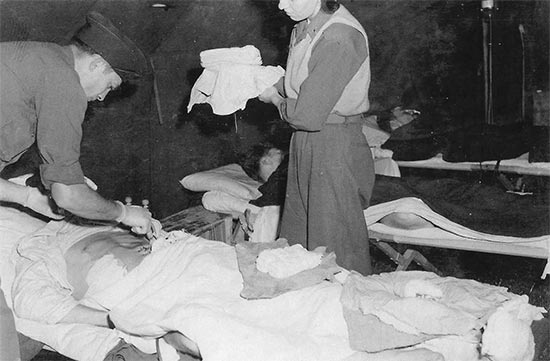
Vintage photo illustrating medical personnel pertaining to Unit I, 11th Field Hospital, at work. Photo taken early October 1944 in Alsace, France.
On 22 November, Unit III moved to a site one-half mile west of Eloyes in 2½-ton trucks of the 103d Infantry Division to Nompatelize. Upon arrival at the new site, personnel were forced to fill deep mud holes in the roads with rocks and branches before the heavily loaded trucks could proceed into the new area. The ground was water soaked from the heavy rains, and the trucks could not leave the road, necessitating unloading only three trucks at a time and then carrying the equipment by hand or other means some distance to where it was to be used. The situation on top of a hill with no windbreak hampered the efficient pitching of tents. With pins continually pulling out of the soft ground aided by severe gusts of wind, tentage simply collapsed frequently before it could be stabilized. Added difficulties were the heavy rains and the laying of wooden floors in tents over numerous shell holes. Even an abandoned dead German was removed from the area. Unit III admitted 54 patients of different nationalities, operated on 22, and used 77 units of plasma on 32 patients. Ninety-seven (97) units of blood and 8,500,000 units of penicillin were used.
On 25 November 1944, Unit I, traveling in trucks of the 636th and 753d Tank Destroyer Battalions, moved thirty miles from Bruyères to the second floor of an old factory building situated in the village of Ban-de-Laveline. The factory was unoccupied and filthy, and it took a whole day to haul out rubbish, scrub the floors, and disinfect the premises. The building was presentable when the Unit moved in. During this period, Unit I supported the Divisional Clearing Station. Blood was furnished this Unit and Unit III by the 1st Medical Laboratory Blood Bank.
On 28 November 1944, Private Joseph Levine, a member of Unit I, while on duty was riding near Saint-Dié-les-Vosges, in an ambulance of the 103d Infantry Division Clearing Company, when the vehicle was wrecked as it drove over a German landmine injuring the soldier. A Purple Heart was awarded to the Enlisted Man for injuries received as a direct result of enemy action.
On 29 November, Unit III left Nompatelize, leaving a Holding Company behind, and moved to a new location at Le Hohwald, traveling a distance of eighty-seven miles. The Hospital set up in a resort hotel, well cleaned and maintained. The building was heated by steam and as there was enough room, the personnel were quartered in the same place. Unit II did not function during this period. On 20 November the Hospital had moved from Epinal to an area one mile east of Eloyes where they stored the equipment with Headquarters. All their personnel were eventually attached to Unit I and III until such a time as there should come a call for another Unit…
Headquarters had meanwhile left Eloyes on 28 November 1944 to settle in a school building in Bruyères. They left Bruyères on 30 November, traveling thirty-two miles in organic trucks to Sainte-Marie-aux-Mines, where they again established their Hospital in an empty school building. This did however not go without preliminary cleaning as the building had been used by the Germans for barracks, and the place was filled with bunks, straw, and refuse.
November 1944 saw some changes and promotions among the Medical and Army Nurse Corps Officers.
December 1944 was characterized by a stalemate along the entire front and fierce German counterattacks resulting in a large number of admissions to the Units of the organization necessitating attachment of additional nursing and Enlisted ward personnel. Several Nurses of the 237th General Hospital were placed on TD with Units at various periods during the month. An important number of Medical and Surgical Technicians of the 52d and 56th Medical Battalions were also placed on temporary duty with the 11th Field Hospital in December.
On 2 December, Unit I left Ban-de-Laveline to set up a Hospital at Sainte-Marie-aux-Mines leaving behind a Holding Company at Ban-de-Laveline. On 4 December 1944, Holding Unit III left the Nompatelize area to join their parent unit at Le Hohwald, in order to assist in supporting the 103d Infantry Division. On 8 December, Unit III left Le Hohwald and moved on to Ribeauville which at the time was only 4 miles from the front! This sector was very active and the town itself was under constant shellfire from enemy heavy artillery. When four days later, the area was subjected to heavy 210mm railroad artillery, the Unit was ordered by 36th Infantry Division Headquarters to evacuate all patients and close the installation. This was accomplished the same day, with Unit III moving into bivouac with Headquarters at Sainte-Marie-aux-Mines. Meanwhile on 10 December, Holding Unit I left Ban-de-Laveline to join Unit I at Sainte-Marie-aux-Mines. By 18 December 1944, Unit III moved out in support of the Second French Armored Division (Deuxième Division Blindée –ed) to Strasbourg. Since this unit was engaged largely in patrol activity a the time, admissions were few. On 28 December, after German troops had crossed the Rhine River to the north and threatened Strasbourg, Unit III was again ordered to close their Hospital and move back to the rear. The best available location became Le Hohwald, where the Unit set up again the same day. The position of Ribeauville having again become less exposed, Unit II was ordered to move there at once and set up in the same building formerly occupied by Unit III on 23 December. This was the first time Unit II had set up since they closed their Hospital at Epinal in November.
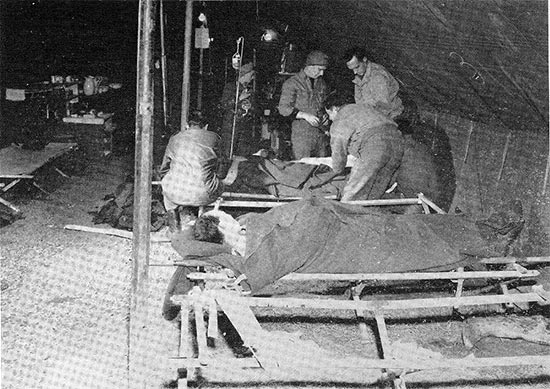
General overview of the Shock Ward at the 11th Field Hospital.
Stations in France – 11th Field Hospital
Sainte-Maxime > 15 August 1944 (Unit II)
Drammont > 15 August 1944 (Headquarters + Units I + III)
Le Muy > 17 August 1944 (Headquarters + Units I + III)
Sainte-Maxime > 17 August 1944 (Unit II)
Draguignan > 18 August 1944 (Headquarters + Unit I)
Saint-Martin > 20 August 1944 (Unit II)
Draguignan > 20 August 1944 (Unit III)
Saint-Paul-lès-Durance > 21 August 1944 (Unit II)
Les Bons-Enfants > 21 August 1944 (Unit III)
Aspres-sur-Buëch > 22 August 1944 (Unit I)
Crest > 23 August 1944 (Unit I)
Les Bons-Enfants > 24 August 1944 (Headquarters)
Crest > 24 August 1944 (Headquarters)
Crest > 25 August 1944 (Unit III)
Montrond > 26 August 1944 (Unit II)
Varces > 27 August 1944 (Unit II)
Morestel > 31 August 1944 (Unit II)
Diemoz > 2 September 1944 (Unit III)
Morestel > 2 September 1944 (Unit II)
Pont d’Ain > 2 September 1944 (Unit II)
Bohas > 4 September 1944 (Headquarters)
Attignat > 5 September 1944 (Headquarters + Unit III)
Cesancey > 5 September 1944 (Unit II)
Chantrans > 6 September 1944 (Unit II)
Etalans > 8 September 1944 (Unit II)
Le Chay > 9 September 1944 (Headquarters)
Quingey > 9 September 1944 (Unit III)
Fretigney > 11 September 1944 (Unit III)
Le Chay > 11 September 1944 (Unit I)
Baume-les-Dames > 11 September 1944 (Unit II)
Saulx > 15 September 1944 (Unit I)
Luxeuil-les-Bains > 18 September 1944 (Headquarters)
Plombières-les-Bains > 20 September 1944 (Unit I)
Bains-les-Bains > 21 September 1944 (Unit II)
Plombières-les-Bains > 22 September 1944 (Unit III)
Eloyes > 25 September 1944 (Unit III)
Epinal > 27 September 1944 (Unit II)
Eloyes > 29 September 1944 (Headquarters)
Epinal > 2 October 1944 (Unit II)
Eloyes > 7 October 1944 (Unit I)
Bruyères > 2 November 1944 (Unit I)
Eloyes > 20 November 1944 (Unit II)
Nompatelize > 22 November 1944 (Unit III)
Ban-de-Laveline > 25 November 1944 (Unit I)
Le Hohwald > 29 November 1944 (Unit III)
Sainte-Marie-aux-Mines > 30 November 1944 (Headquarters)
Ban-de-Laveline > 2 December 1944 (Unit I)
Sainte-Marie-aux-Mines > 2 December 1944 (Unit I)
Le Hohwald > 4 December 1944 (Unit III)
Ribeauville > 8 December 1944 (Unit III)
Sainte-Marie-aux-Mines > 14 December 1944 (Unit III)
Strasbourg > 18 December 1944 (Unit III)
Le Hohwald > 28 December 1944 (Unit III)
Sarrebourg > 7 January 1945 (Headquarters)
Sainte-Marie-aux-Mines > 7 January 1945 (Unit II)
Sarrebourg > 8 January 1945 (Unit III)
Sarrebourg > 10 January 1945 (Unit II)
Saverne > 13 January 1945 (Headquarters)
Bouxwiller > 18 January 1945 (Unit II)
Phalsbourg > 21 January 1945 (Unit II)
Ribeauville > 22 January 1945 (Unit I)
Hochfelden > 30 January 1945 (Unit III)
Stephansfeld > 31 January 1945 (Unit I)
La-Petite-Pierre > 13 March 1945 (Unit II)
Mertzweiler > 18 March 1945 (Unit I)
Drachenbronn > 19 March 1945 (Unit I)
Ingolsheim > 21 March 1945 (Unit III)
Surbourg > 22 March 1945 (Headquarters)
Ingolsheim > 28 March 1945 (Unit III)
During the month of January 1945, all Units of the 11th Field were shifted from Southern to Northern Alsace in which the main Seventh Army effort was now being directed. Because of the weather, and if available, buildings were used exclusively for the Hospitals proper and also for housing staff and personnel which greatly simplified the problems which had assumed major importance the previous winter spent in tented hospitals in the Monte Cassino area. Reconnaissance in advance of the actual moves insured selection of suitable buildings, and because of the relatively small bed capacity of the Units (maximum 50 beds), it was possible to utilize sites that would have been inadequate for larger medical installations. Alternate periods of rain and snow in addition to heavy traffic damaged roads considerably, but since the distance to Evacuation Hospitals was never that great, evacuation fortunately presented no serious difficulties.
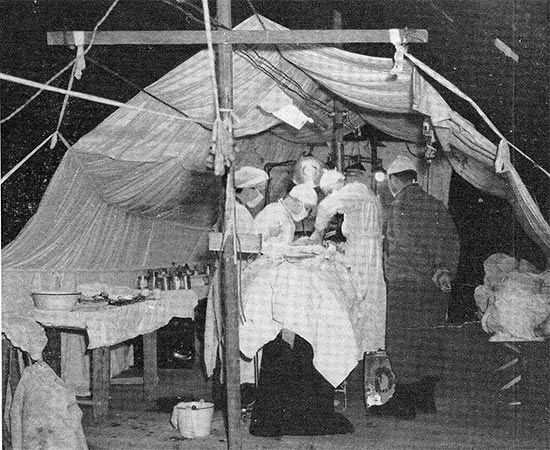
Illustration demonstrating standard operating procedure in the field. Photograph taken at the 11th Field Hospital.
On 7 January 1945, Headquarters moved by truck from Sainte-Marie-aux-Mines to Sarrebourg, a distance of 59 miles. On the same date, Unit II was forced, because of heavy enemy shelling, to close their Hospital at Ribeauville and move into bivouac at Sainte-Marie-aux-Mines in the building just vacated by Headquarters. On 8 January Unit III joined Headquarters at Sarrebourg and bivouacked. On 10 January, Unit II left Sainte-Marie-aux-Mines and bivouacked with Headquarters and Unit III at Sarrebourg.
In January-February 1945, a mass award ceremony took place in Hochfelden, France, during which many Good Conduct Medals were awarded to a large number of Noncoms and Enlisted personnel.
Unit I still established at Sainte-Marie-aux-Mines in support of the 3d Infantry Division, were at that time the only Unit remaining in operation in Southern Alsace. Since providing supplies and rations there on a daily basis would have presented considerable difficulties, Unit I were attached on 11 January 1945 to the 3d Infantry Division for operations, supply, and rations, with administration remaining with Headquarters, 11th Field Hospital. On 13 January 1945, Headquarters moved seventeen miles forward to Saverne, a more centralized location. On 18 January, Unit II left Sarrebourg for Bouxwiller, where they set up their Hospital in support of the 103d Infantry Division. At this time however, the enemy launched a counterattack in strength south of Hagenau which might have developed into a real threat to the American flank. Consequently the line was pulled back and as the position of the Unit became untenable, they were forced to move approximately twenty-five miles back to Phalsbourg, where they took over a Hospital operated by Hospitalization Unit III of the 57th Field Hospital which were being sent to Southern Alsace to support the French Deuxième Division Blindée.
On 22 January, Unit I left Sainte-Marie-aux-Mines and moved to Ribeauville to set up their facilities in the same building previously occupied by Units II and III. On 30 January 1945, Unit III was in Hochfelden where they medically supported the 101st Airborne and the 79th Infantry Divisions. At the end of January, Unit I entrucked for Stephansfeld to set up a hospital in support of the 36th Infantry Division, their site at Ribeauville being taken over by Hospitalization Unit III of the 57th Field Hospital.
Since the front was relatively quiet during the latter part of January 1945, the organization was able to support a larger number of Army / Corps Divisions than was customary.
During winter, road conditions in Alsace and other parts of northeastern France were a continuous hazard, and driving on mountain roads covered with mud, snow, and ice was truly treacherous. Not only did water freeze in the Lyster bags, and the stoves malfunctioned, but in order to combat the intense cold, whenever possible, personnel would try and find billets in sheds, barns, and stables for additional protection against the weather elements.
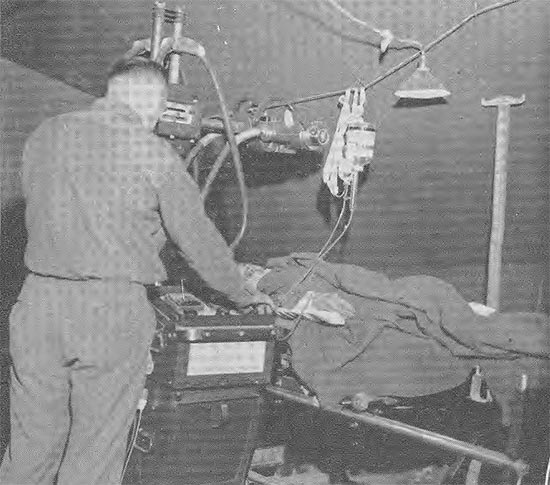
Picture showing x-ray techniques under canvas at the 11th Field Hospital. The photograph was taken during the unit’s time in France.
Several changes in Officer personnel took place during the month, including promotions and replacements.
Since the Seventh US Army front remained relatively stable during February 1945, Headquarters and the 3 Units remained in position at their respective sites; Headquarters (Saverne), Unit I (Stephansfeld), Unit II (Phalsbourg), and Unit III (Hochfelden).
On 7 February, Unit I was relieved from attachement to the 3d Infantry Division, and reverted to control of Headquarters, 11th Field Hospital. Another series of changes in Officer personnel took place, more particularly affecting ANC personnel.
On 8 March 1945, Lieutenant Colonel Herman E.Wilkinson, MC, Commanding Officer, 11th Field Hospital, was awarded the Bronze Star Medal for “meritorious service in direct support of combat operations” per General Order # 69, Headquarters, Seventh United States Army, dated 28 February 1945.
Second Lieutenant Eugene J. Benolken was awarded the Bronze Star Medal per General Order # 43, Headquarters, MTOUSA, dated 11 March 1945.
Major Lewell S. Walker, Jr., MC; Captain Leon M. Levitt, MC; First Lieutenant Emma J. Hall, ANC; Technician 4th Grade Robert L. Chapman, MD; and Technician 4th Grade Willard C. Denbow, MD were awarded the Bronze Star Medal per General Order # 102, Headquarters, 36th Infantry Division, dated 29 March 1945.
The first ten days of March 1945 were uneventful largely because preparations for the drive to the Rhine River had confined combat units to consolidation of their positions and other necessary arrangements. On 13 March, Unit II departed Phalsbourg for La-Petite-Pierre where they established a Hospital in conjunction with the 122d Medical Battalion of the 42d Infantry Division. On 15 March, one hundred two non-transportable cases were admitted to the Hospital, including forty-one traumatic amputations of one or both legs, the largest number of cases so far received in a single day. Headquarters and the different Units kept moving almost constantly to keep pace with the fast moving Divisions. On 18 March 1945, Unit I moved from Stephansfeld to Drachenbronn, France; arriving there on 19 March, after bivouacking overnight at Mertzweiler. In this area they worked together with the 111th Medical Battalion, 36th Infantry Division, and the 328th Medical Battalion, organic medical unit of the 103d Infantry Division. On 21 March, the Clearing Station of the 36th Infantry Division having again moved forward, Unit III proceeded in support to Ingolsheim. The following day, Headquarters left Saverne, to move one mile west of Surbourg, also in France.
Germany:
On 26 March 1945, Headqquarters and Unit I crossed the German border, with Headquarters setting up at Lambrecht, Germany, and Unit I going to Klingenmünster, Germany, both in bivouac.
At this time it really became necessary to move the 11th Field Hospital across the Rhine since resistance on the Western side had practically collapsed. Consequently the entire organization moved to an Assembly Area one mile west of Göllheim, Germany. Unit II arrived on site on 29 March, after bivouacking first at Rumbach, and Headquarters proceeded there from Lambrecht on the same date. Unit I entrucked for Göllheim on 30 March, bivouacked there overnight, and proceeded further moving fifty miles east of the Rhine River to a placed called Erbach, the following day. On 31 March 1945, Unit III joined Headquarters and Unit II at Göllheim, Germany.
Some Officers received promotions during this period, while two new ANC Officers joined the organization from the 2d Reinforcement Depot.

The 11th Field Hospital’s unit sign displayed outside of the facility in Erbach, Germany.
April 1945 saw the 11th Field Hospital travel east into the heart of Germany, and then going south toward the Austrian border. Twenty-three (23) different moves were made during the month by the three Units, exclusive of moves by Holding Units. The entire period was spent in medical support of units pertaining to XXI Corps, such as the 3d – 4th – 42d – and 63d Infantry Divisions.
On 2 April 1945, Headquarters and Unit III left the Assembly Area at Göllheim, Germany, from where they moved across the Rhine River at Worms and proceeded to Erbach, where Unit I were already operating. Upon arrival at Erbach, Unit I which were in demand at a more forward location, left immediately for Tauberbischofsheim, Germany. On the same day, Unit II also crossed the Rhine and went into bivouac at Miltenberg. They moved out however on the following day to set up a Hospital at Wüstenzell. On 4 April, after a tenure of forty-eight hours at Erbach, Headquarters entrucked for Höpfingen, in order to keep pace with rapid movement of Seventh US Army units. On 6 April, Unit III departed Erbach and moved to a new site at Würzburg, Germany, which they reached on 7 April, after first bivouacking overnight at Wüstenzell.
By 13 April 1945, Unit I had already moved to Bad Mergentheim and set up their facility. The following day, 14 April, Headquarters entrucked for a new position three-quarters of a mile north of Marktbreit. On 15 April 1945, Unit I began a two-day motor convoy to Langenfeld, arriving at their new destination the following day after bivouacking first at Markt Einersheim, Germany. On 18 April, Unit III moved to a position adjacent to Headquarters, some three-quarters of a mile north of Marktbreit, but since casualties were light, they did not set up. On 19 April Unit I moved on to Rothenburg, where they set up for three days, before entrucking for Satteldorf on 22 April 1945. On 20 April, Headquarters moved to Bettwar, still in Germany, and on 21 April, Unit III moved further to Wolpertshausen, where they operated for three days before moving to Leinzell on 24 April. On 25 April, Unit II were in Dillingen on the north bank of the Danube where they bivouacked. Unit I moved to Aislingen and on the following day Headquarters traveled to Dillingen. Meanwhile Unit I had entrucked for Mödishofen, which they left on 1 May 1945, in order to proceed by motor convoy to a new installation site about one and one-quarter miles north of Starnberg, Germany. Their primary task consisted in supporting the 4th Infantry Division. On 2 May, Headquarters left Dillingen, for a new site at Sankt Alban. The same day, Unit III departed Leinzell for a new location at Bad Tölz, Germany, arriving on 3 May after bivouacking overnight at Weilheim. Operations at Bad Tölz were in support of the 36th Infantry Division. By 6 may 1945, Unit III had left Bad Tölz, Germany, and set up their Hospital at Kufstein, Austria, again in support of the same unit.
On 9 May, Unit I closed their facility near Starnberg, Germany, in order to move to Sankt Alban, where they bivouacked not far from Headquarters. On 10 May, Unit II left Wertingen, and also bivouacked adjacent to Headquarters of the organization. On 11 May, Unit III left Kufstein, Austria, and returned to Germany, going into bivouac at Sankt Alban, together with Headquarters and the other two Units.
The next few days were spent in checking and inventorying equipment, and preparing for a new operation.
On 16 May 1945, Unit II had departed Sankt Alban for a location a half-mile northeast of Oberdiebach, Germany, where they began to set up a Station Hospital under tentage for troops of XXI Corps. They were joined the following day by Unit I which had moved from Sankt Alban, and together opened the Hospital. On 19 May, Headquarters also entrucked for the Oberdiebach area. On the same day, a reconnaissance party with personnel pertaining to Unit I and II discovered in the nearby town of Eberbach, a building ideally suited for the Station Hospital type of function. It was a three-story building well supplied with electric lighting, running water, and steam heat, and large enough to accommodate and operate a 300-bed Hospital.
Consequently, on 20 May, Headquarters and Unit II immediately proceeded to Eberbach where the Hospital was re-opened at 1500 hours. Unit I remained in Oberdiebach until the next day, but transferred such patients as had already been admitted to Eberbach on the evening of 20 May. Unit III left Sankt Alban on 20 May 1945 entrucking directly for Eberbach. On 21 May, the entire organization was now operating as ONE unit for the first time since March 1944. They initially serviced the 63d and 86th Infantry Divisions, the 65th Infantry Regiment, Separate, and numerous other service organizations established in the area. The 409th Motor Ambulance Company was placed on TD with 11th Field, and such patients as could not be treated definitively were evacuated by air to General Hospitals or other installations of the Communications Zone. Two (2) Surgical Teams belonging to the 2d Auxiliary Surgical Group were also assigned on a temporary basis with the organization to provide extra surgical treatment. For the balance of May, an average of about 35 surgical cases per day were admitted.
As soon as hostilities had ended, and operations had diminished in intensity, Headquarters and all Units joined at the Ammersee in Bavaria, Germany, and it was there, following a few days of rest and recreation that the entire organization entrucked for Eberbach to establish a Station Hospital. High point men now started leaving the unit to return to the ZI, and low-point men were transferred from other organizations. The 11th Field Hospital, now designated a Category IV unit, was going home at last.
Redeployment to the Zone of Interior took place on 11 November 1945. The organization reached Boston Port of Embarkation, traveling aboard Liberty Ship “William D. Pender” (Liberty ship, laid down 30 January 1943, and launched 28 February 1943, took part in Operation “Dragoon, 15 August 1944 –ed) which left Marseille, Southern France, arriving at destination (Boston P/E) 20 November 1945 and after moving to Camp Myles Standish, Boston, Massachusetts (Staging Area for Boston P/E; acreage 1,485; troop capacity 1,298 Officers and 23,100 Enlisted Men –ed) it was officially inactivated on 21 November 1945.
Stations in Germany – 11th Field Hospital
Lambrecht > 26 March 1945 (Headquarters)
Klingenmünster > 26 March 1945 (Unit I)
Rumbach > 28 March 1945 (Unit II)
Göllheim > 29 March 1945 (Headquarters + Unit II)
Göllheim > 30 March 1945 (Unit I)
Göllheim > 31 March 1945 (Unit III)
Erbach > 31 March 1945 (Unit I)
Erbach > 2 April 1945 (Headquarters + Unit III)
Miltenberg > 2 April 1945 (Unit II)
Erbach > 2 April 1945 (Unit III)
Wüstenzell > 3 April 1945 (Unit II)
Höpfingen > 4 April 1945 (Headquarters)
Wüstenzell > 6 April 1945 (Unit III)
Würzburg > 7 April 1945 (Unit III)
Tauberbischofsheim > 12 April 1945 (Unit I)
Bad Mergentheim > 13 April 1945 (Unit I)
Marktbreit > 14 April 1945 (Headquarters)
Markt Einersheim > 15 April 1945 (Unit II)
Langenfeld > 16 April 1945 (Unit II)
Marktbreit > 18 April 1945 (Unit III)
Rothenburg > 19 April 1945 (Unit I)
Bettwar > 20 April 1945 (Headquarters)
Wolpertshausen > 21 April 1945 (Unit III)
Satteldorf > 22 April 1945 (Unit I)
Leinzell > 24 April 1945 (Unit III)
Aufhausen > 25 April 1945 (Unit I)
Aislingen > 26 April 1945 (Unit I)
Dillingen > 26 April 1945 (Unit II)
Wertingen > 27 April 1945 (Unit II)
Dillingen > 28 April 1945 (Headquarters)
Mödishofen > 28 April 1945 (Unit I)
Starnberg > 1 May 1945 (Unit I)
Sankt Alban > 2 May 1945 (Headquarters)
Weilheim > 2 May 1945 (Unit III)
Bad Tölz > 3 May 1945 (Unit III)
Starnberg > 9 May 1945 (Unit I)
Sankt Alban > 9 May 1945 (Unit I)
Sankt Alban > 10 May 1945 (Unit II)
Sankt Alban > 11 May 1945 (Unit III)
Oberdiebach > 16 May 1945 (Unit II)
Oberdiebach > 17 May 1945 (Unit I)
Oberdiebach > 19 May 1945 (Headquarters)
Eberbach > 20 May 1945 (Headquarters + Unit II)
Eberbach > 21 May 1945 (Unit I + III)
Eberbach > 21 May 1945 (Headquarters + all Units)
Station in Austria – 11th Field Hospital
Kufstein > 6 May 1945 (Unit III)
Austria:
Apart from Unit III’s short escapade into Northern Austria (Tyrol), no other units operated in Austria.
Official Campaign Credits – 11th Field Hospital
Sicily
Naples-Foggia
Rome-Arno
Southern, France
Rhineland
Central Europe
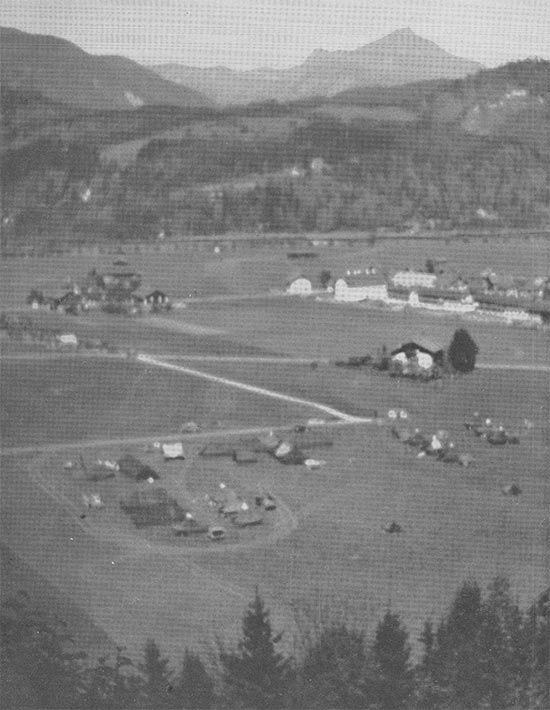
Partial aerial view showing the facility maintained by Unit III, 11th Field Hospital in Kufstein, Austria.
Fifth United States Army Commendation – 11th Field hospital
Hospitalization Unit II, 11th Field Hospital is awarded the Fifth US Army Plaque and Clasp for meritorious service during the month of January 1944. Often in the face of serious obstacles, this organization established an outstanding record in the performance of services invaluable to Fifth United States Army. This Unit displayed a high degree of skill in fulfilling a vital mission which resulted in saving the lives of our wounded soldiers. Reliance is put upon Hospitalization Unit II, 11th Field Hospital to maintain its record in the days that lie ahead.
signed, Mark W. Clark,Lieutenant General,Fifth United States Army,Commanding.1944
Meritorious Service Unit Plaque – 11th Field HospitalThe 11th Field Hospital is awarded the Meritorious Service Unit Plaque for superior performance of duty in the accomplishment of exceptionally difficult tasks for the period 15 August 1944 to 30 November 1944, in France. Assigned the task of rendering medical support to the 36th and 45th Infantry Division Clearing Stations during amphibious operations in Southern France and acting in the same capacity for other Divisions in the subsequent land operations, members of the 11th Field Hospital performed their duties in a superior manner at all times and under many trying conditions. The excellent cooperation and aggressive nature of each member of the Hospital has been of immeasurable value to the welfare of sick and wounded personnel passing through this installation.
signed, Alexander M. Patch, Jr.Lieutenant General,Seventh United States Army,Commanding.February 28, 1945
Personnel Roster: (incomplete)
MC Officers:
| Lieutenant Colonel Herman E. Wilkinson, MC | Captain Ivan A. McQuire, MC |
| Major Joseph H. Barnard, MC | Captain Stephan K. Molnar, MC |
| Major Claude D. Bonham, MC | Captain Francis Pavlovsky, DC |
| Major Harry Borsuk, MC | Captain Russell W. Price, MAC |
| Major Ernest L. Boylen, MC | Captain Stephan W. Ranson, MC |
| Major Lewell S. Walker, Jr., MC | Captain Leroy E. Schiller, DC |
| Captain Carl A. Asher, DC | Captain William Schongalla, Jr., MAC |
| Captain Gareth B. Barnes, MC | Captain Lewis B. Stephan, MC |
| Captain Fred T. Burich, MC | Captain Leonard B. Thompson, MC |
| Captain George A. Curtis, MC | Captain James A. Wolff, MC |
| Captain Rino Della Vedova, MAC | Captain Norman C. Woody, Jr., MC |
| Captain Cyrus D. Eastman, MC | First Lieutenant William L. Davis, MAC |
| Captain Waldo W. Forsman, MC | First Lieutenant Sidney D. Ellman, MC |
| Captain Ernst J. C. Jehn, ChC | First Lieutenant Frank T. Hughes, Jr., MAC |
| Captain Herman K. Koschnitzke, MC | First Lieutenant Marvin R. Kahn, MAC |
| Captain Harry J. Lange, MC | Second Lieutenant Eugene J. Benolken, MAC |
| Captain Leon M. Levitt, MC | Second Lieutenant B. D. Ramsley, MC |
+
| Johnny Adams | John R. Hill |
| George S. Aspnes | Robert I. Hiller |
| Ralph Biehn | Israel Kopp |
| Charles R. Castlen | Lynn M. Rudee |
| John S. Fish | Alexander F. Russell |
| Auten Hanford |
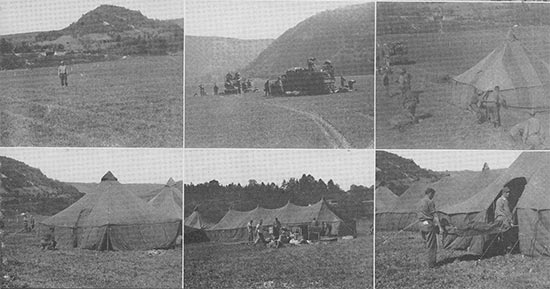
Collage of photographs showing the general duties of staff at the 11th Field Hospital.
ANC Officers:
| Captain Margaret W. Sydel, ANC | First Lieutenant Pauline M. Skalos, ANC |
| First Lieutenant Dorothy R. Collins, ANC | First Lieutenant Hazel M. Stegman, ANC |
| First Lieutenant Cordelia E. Cook, ANC | First Lieutenant Reba F. Switzer, ANC |
| First Lieutenant Wilma C. Enot, ANC | First Lieutenant Catherine E. Ziegler, ANC |
| First Lieutenant Nona M. French, ANC | Second Lieutenant Anne M. Cameron, ANC |
| First Lieutenant Virginia L. Haase, ANC | Second Lieutenant Mary L. Cox, ANC |
| First Lieutenant Emma J. Hall, ANC | Second Lieutenant Dolores I. Dowling, ANC |
| First Lieutenant Ina E. Henke, ANC | Second Lieutenant Edna M. Jacinto, ANC |
| First Lieutenant Marjorie V. Houghton, ANC | Second Lieutenant Mary M. Masek, ANC |
| First Lieutenant Mary T. Jenkins, ANC | Second Lieutenant Miriam K. Miller, ANC |
| First Lieutenant Florence E. Kuznik, ANC | Second Lieutenant Mae B. Simmons, ANC |
| First Lieutenant Frances Mosher, ANC | Second Lieutenant Margaret A. Stupak, ANC |
| First Lieutenant Virgie G. Neel, ANC | Second Lieutenant Bernadine Sturniolo, ANC |
| First Lieutenant Geneva M. Seevers, ANC |
+
| Loretta Commini, ANC | Carroll R. Ragland, ANC |
| Dye Dorothy, ANC | Carroll G. Renaud, ANC |
| Ruth Hindman, ANC | Kathryn Scheid, ANC |
| Phyllis McGivern, ANC | Evelyn A. Smith, ANC |
| Kathleen Miller, ANC | Juanita E. Tann, ANC |
| Lee Miller, ANC | Nellie Wrigley, ANC |
| Theresa M. Powers, ANC |
Enlisted Men:
| Technician 3d Grade Maynard O. Stromberg | Corporal David D. Behan |
| Technician 4th Grade Robert L. Chapman | Private First Class Theodore W. Weibel |
| Technician 4th Grade Willard C. Denbow | Private Joseph Levine |
| Technician 4th Grade Eugene A. Fletcher, Jr. |
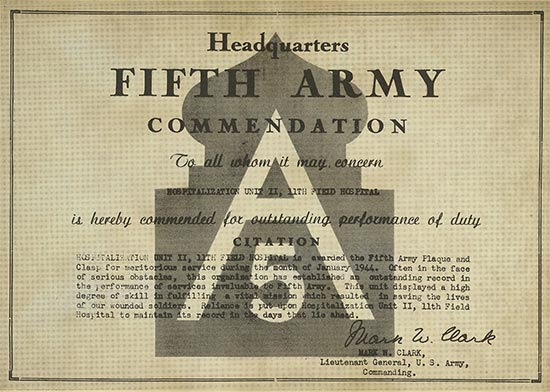
Copy of the official Fifth United States Army Commendation awarded to Unit II, 11th Field Hospital by Lt. Gen. Mark M. Clark.
Officers, Noncommissioned Officers & Enlisted Men:
| + | |
| Robert V. Allen | Charles F. Lewis |
| Santo Allegro | Vasco B. Lisboa |
| Raymond H. Allen, Jr. | John E. Livezey |
| George J. Aubert | Robert M. Lohr |
| George B. Autry, Jr. | Peter M. Luciano |
| Carl A. Bader | Victor Lukasavi |
| Travis B. Baldwin | Francis P. Luketina |
| Raymond M.Barker | Robert R. Lund |
| Hayes S. Barnett | Stanley R. Lundgren |
| Robert M. Barron, Jr. | Guarry D. Mackinnon |
| John R. Bastian | Manuel Mano |
| Palma I. Baxter | Thomas F. Maloney |
| John J. Beach | Edward F. Marshall |
| Charles A. Bertalmio | LeMar Mathews |
| John C. Bibby | Leroy W. Matson |
| Paul G. Bihlman | Leon O. McCumber |
| Joseph C. Blaha | Hollis E. McDaniel |
| John A. Blazonczyk | Harold J. McDonald |
| James D. Blondet | Raymond J. McGowan |
| Giles Bohannon | Antone M. Medeiros |
| Albert W. Boland | Leonard A. Melve |
| Claude E. Bolthouse | Maurice Meyers |
| William Boscovich | Lloyd F. Michael |
| William W. Boyd | Clarence D. Miller |
| James F. Boyer | Vincent Moleta |
| Floyd F. Bump | Frank J. Monaco |
| John J. Burgoyne, Jr. | Lloyd R. Montague |
| Joseph P. Burke | James R. Moor |
| Theron J. Byrd | Charles L. Moore |
| Howard W. Calvert | William H. Moran |
| Jack Carithers | John Moretz |
| George O. Carnathan | Lavon C. Murcer |
| Melvin V. Carter | Aldavin Mustola |
| James M. Chowning | Clifford W. Nyberg |
| Henry S. Chubb | Daniel J. O’Connell |
| Russell B. Clark | Lowell Ogle |
| Edward Cohen | Andrew T. Olson |
| William C. Cole | George J. O’Mara |
| Nathaniel N. Collins | Charles J. Paine |
| Frank J. Colucy | Charles Palazzolo |
| Cecil E. Conrad | Cecil Parker |
| Vincent L. Cook | Samuel E. Parrish |
| John L. Cooper | James N. Patterson |
| Francis E. Cunningham | Louis Pavlik |
| Joseph Czuchnowski, Jr. | Freddie E. Perkins |
| Charles E. De Losier | Hallis H. Perry |
| Lewis De Sandre | George w; Peters, Jr. |
| Roy V. Dillaman | Lowell A. Pickett |
| Paul F. DiLorenzo | Arthur E. Pierce |
| Arthur J. Dion | Ernst W. Pohlman |
| Wallace F. Doyle | Thomas A. Postlewait |
| Gerald A. Duerr | Richard E. Prall |
| Walter J. Duggan | Joseph Prorok |
| Odis M. Duke | Clarence N. Purlee |
| Raymond Edelman | William J. Pustelnik |
| Leon G. Edgell | Peter S. Rafalski |
| William F. Edwards | Clifford E. Ramey |
| David W. Eggleston, Jr. | Leland C. Rasmussen |
| Robert B. Enright | James I. Reed |
| Israel Erieau | Arvid N. Reep |
| Ernest M. Ethridge | Cecil M. Reese |
| John Evans | Leo T. Rice |
| Garrett J. Franken | Milborn W. Rigney |
| Ledger Free | Earl Robinett |
| James Freeland | Collins G. Roderick |
| Henry Friebele | Lee W. Roe, Jr. |
| Herschel W. Frost | John W. Ross |
| Matt J. Gaab | David M. Rubel |
| Felix H. Gajewski | Stanley J. Rubin |
| Howard W. Galbraith | Herman P. Russell |
| John D. Gale | Joseph J. Rzany |
| Joseph Galica | Irvin L. Sanders |
| John M. Gannon | Orville A. Sanders |
| James E. Gardner | John M. Scheve |
| Denzil Garner | David B. Schmitt |
| Robert A. Garrett | Edwin M. Schnur |
| Silveo Gerardi | Calvin A. Segler |
| William Gertz | Albert M. Semites |
| John A. Goit | Sterling B. Shanks |
| Herman J. Golner | Marvin C. Shemwell |
| Cecil A. Goodenough | David Sherbowsky |
| John R. Graff | AAngus L. Sherman |
| William E. Grainger | Hubert L. Short |
| Donald H. Graves | Enoch L. Shuda |
| John W. Green | Gaylord A. Skarweski |
| Carson Haines | August Slanina |
| Laurent E. Hallonquist | Hugh D. Slay |
| Alex J. Hannula | Emmet C. Smith |
| Ernst M. Hansen | Willie Solesbee |
| Neil O. Hanson | Theodore H. Stenson |
| Edward R. Harris | William W. Stevens |
| Rex Harrison | Jack Schwartz |
| William L. Harrison | Noah J. Swartz, Jr. |
| Berten H. Haugen | Herman A. Seltice |
| William P. Hawkin | Paul A. Simon |
| Albert T. Hicks | Emil R. Soukop |
| George N. Hoffman | Douglas Still |
| Will H. Hogan | Paul H. Tack |
| Robert O. Hoham | Edward A. Tashjian |
| Obed Holdren | Anthony J. Tavanese |
| Eathel P. Hollingshead | Raymond L. Taylor |
| Robert M. Houston | Roger L. Thompson |
| Donald O. Hughes | Cecil F. Tibbet |
| John L. Inskeep | Lattie E. Tilson |
| Iver F. Iverson | Edward F. Tomlinson |
| Ben I. Jacobson | Hollis L. Tompkins |
| Duane G. Jensen | Howard H. Trampe |
| Albert W. Johnson | Thomas M. Trimm |
| Alfred S. Johnson | Fred L. Uttley |
| Benjamin F. Johnson | Earl T. Valentine |
| Gustav J. Johnson | Haigas J. Varjabedian |
| William F. Johnson | Butler D. Vaughn |
| Dwight R. Jones | Thomas E. Vaughn |
| George B. Jones | Wesley C. Vemmer |
| Alvin Kaelin | Frank E. Wall |
| William A. Kane | Calvin C. Wallace |
| Richard E. Kanoff | William S. Webb |
| Loyd Kates | Robert R. Weeks |
| Frank Kazia | Ira J. Welch |
| Cornelius E. Kearney | Perry L. West |
| Donald L. Kerchner | Henry S. Westmoreland |
| Roy O. Kies | Thomas J. Wimpee |
| Merle L. King | Donald L. Winchester |
| Dennis Kiper | Winfield S. Woodward |
| David Koch | Joseph Yackobovicz |
| Edward G. Kopischke | Joseph S. Yarsaw |
| John E. Kuhner | Harold H. Zendler |
The MRC Staff are still looking for a complete Personnel Roster including all ranks, if possible. Any additional inputs will be clearly indicated and duly credited. Thank you.
